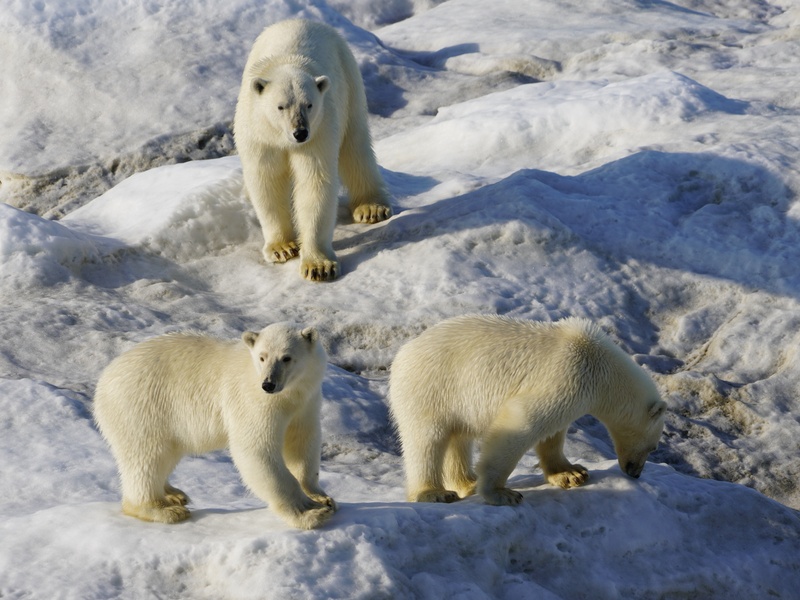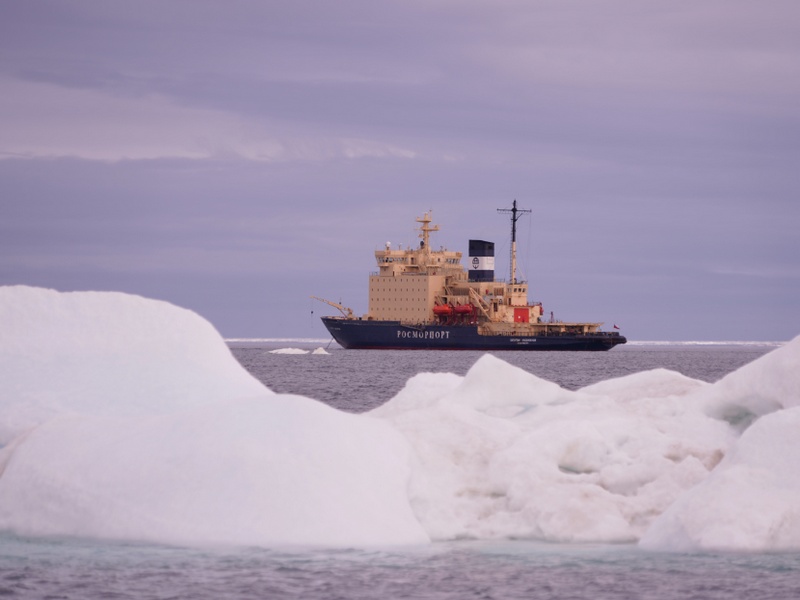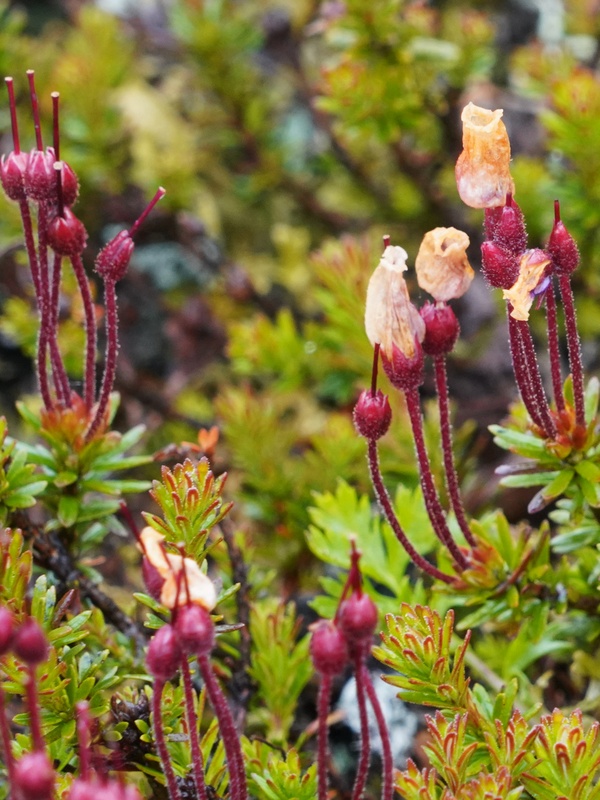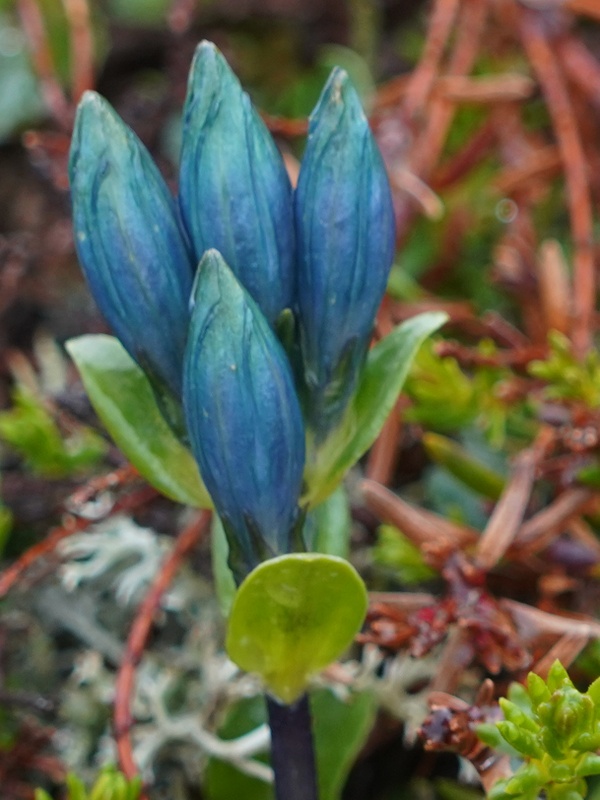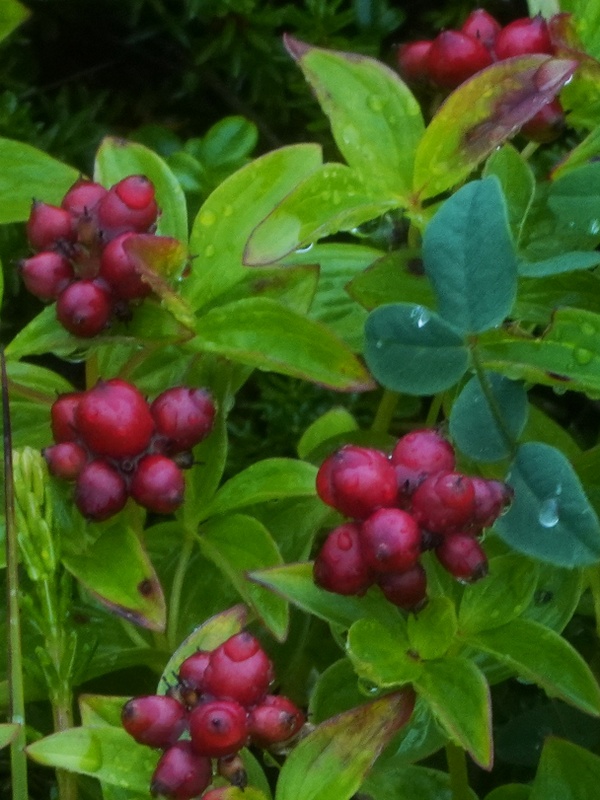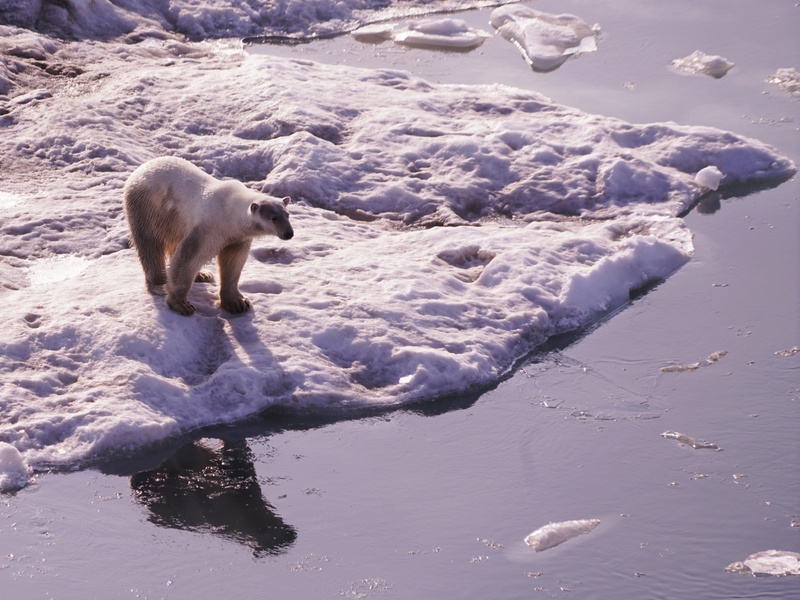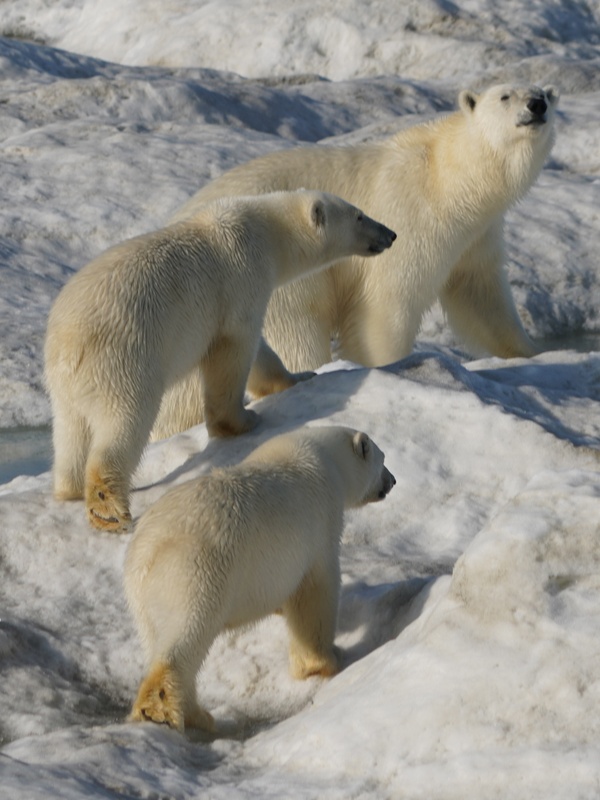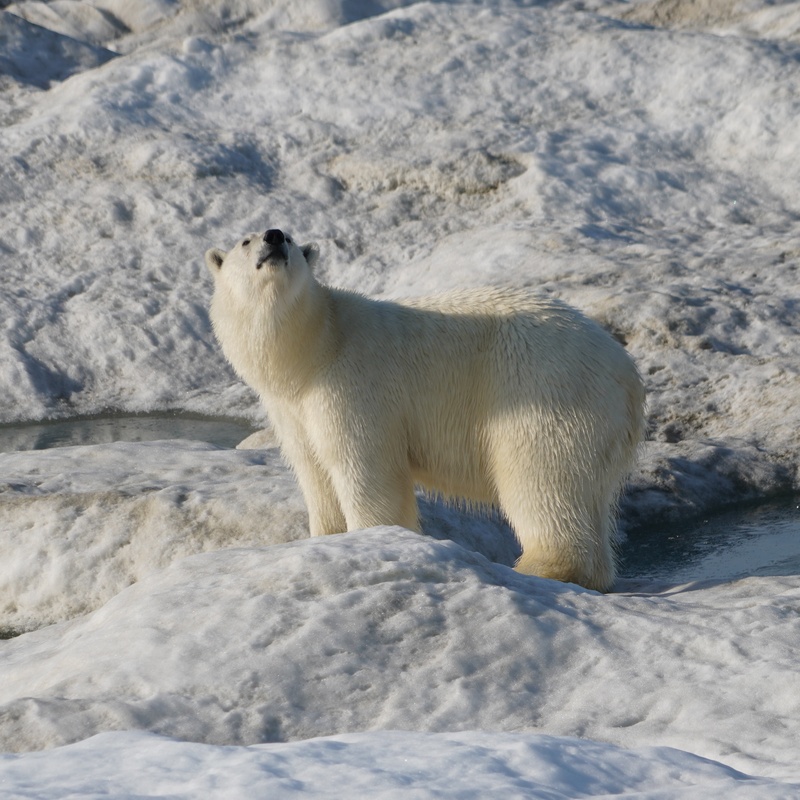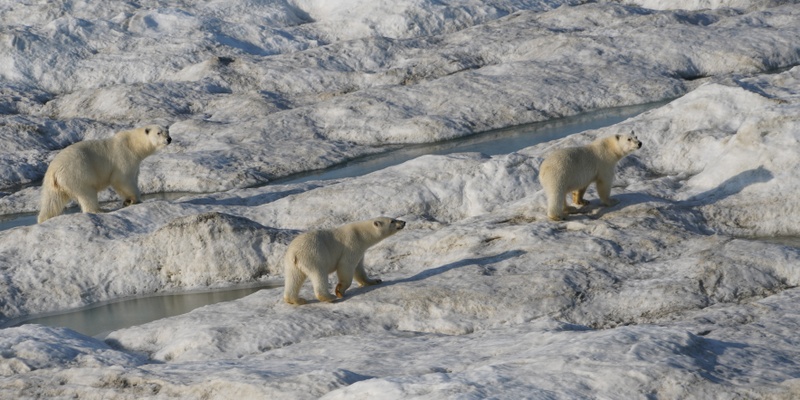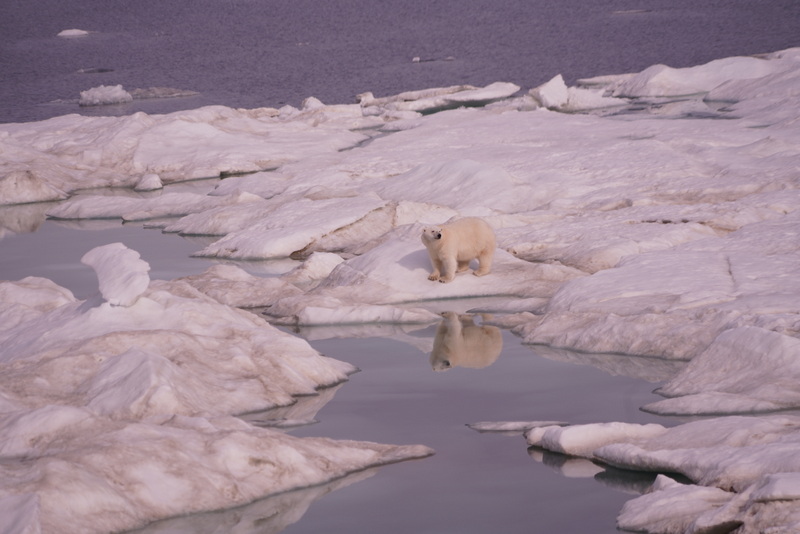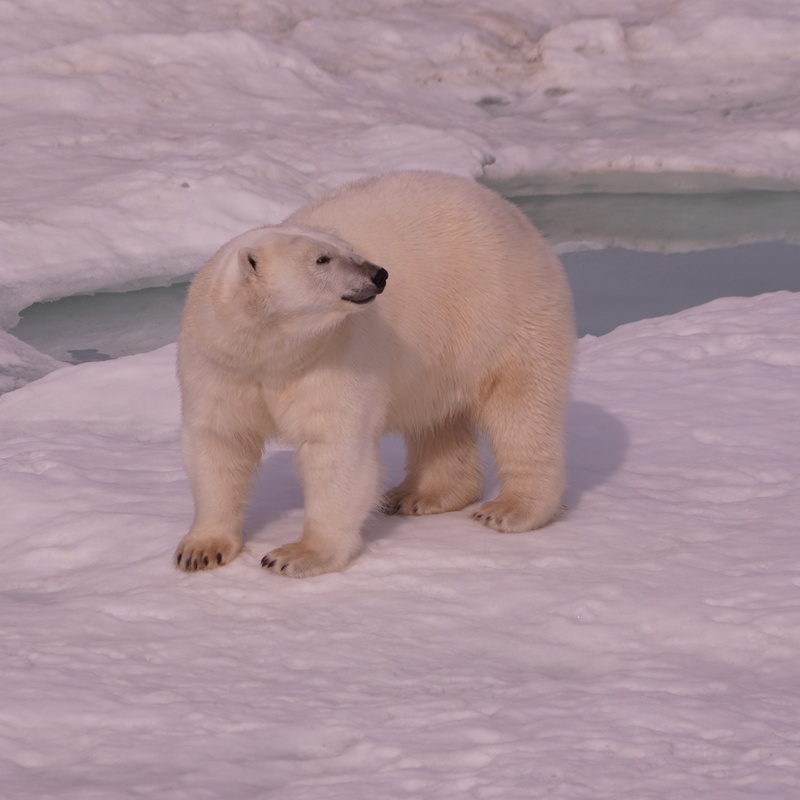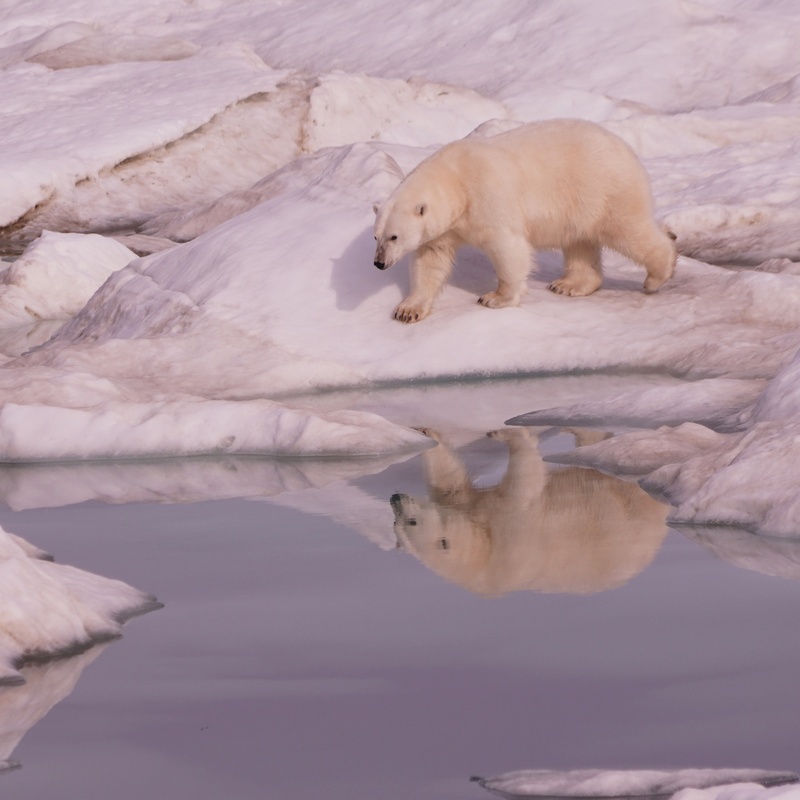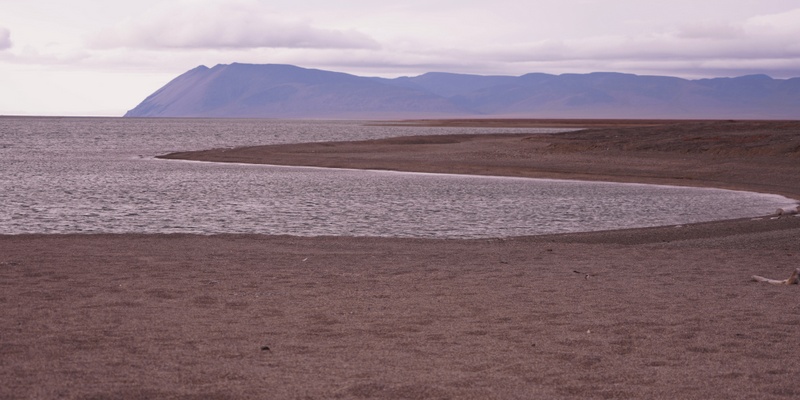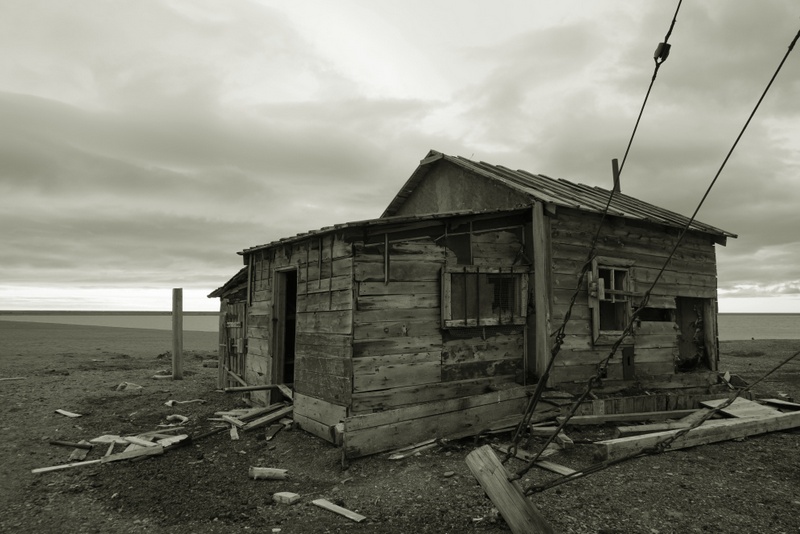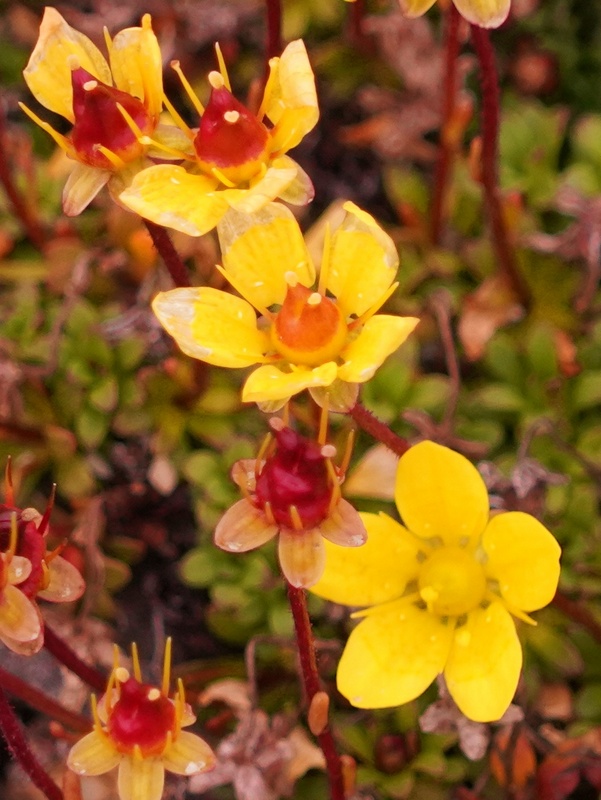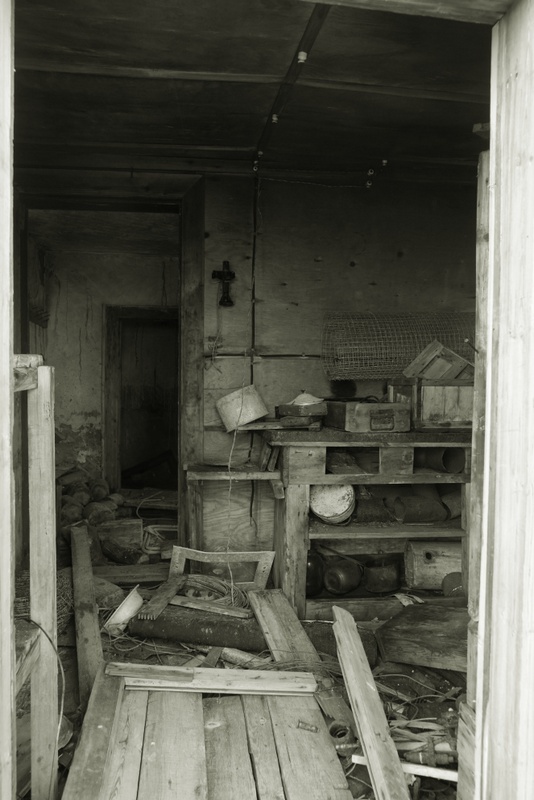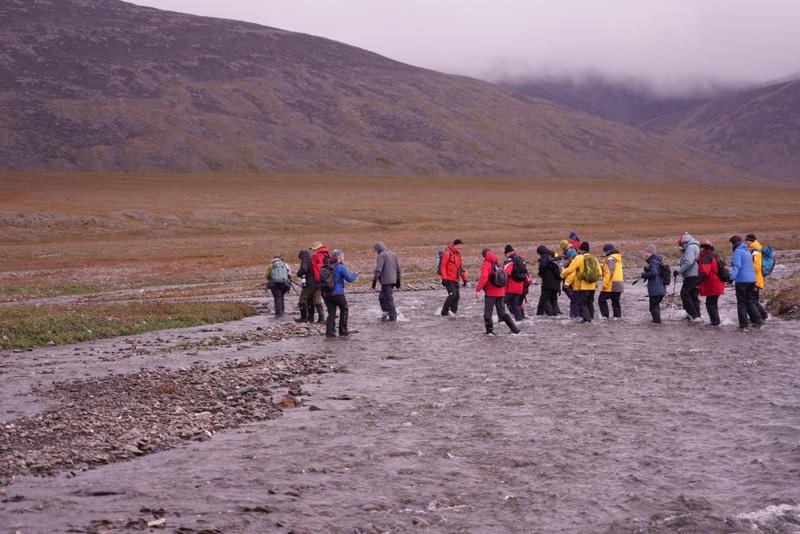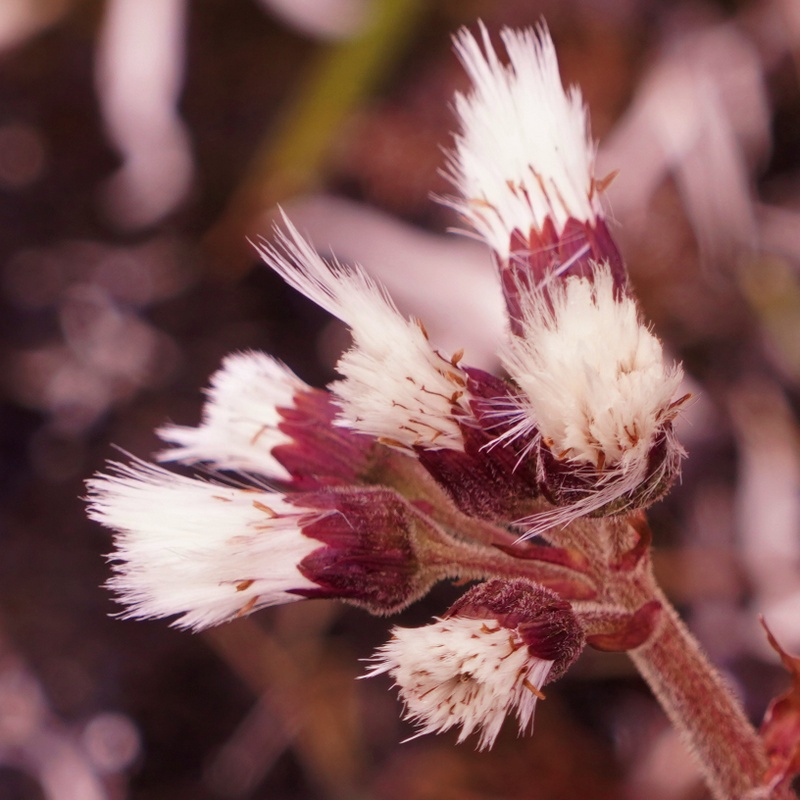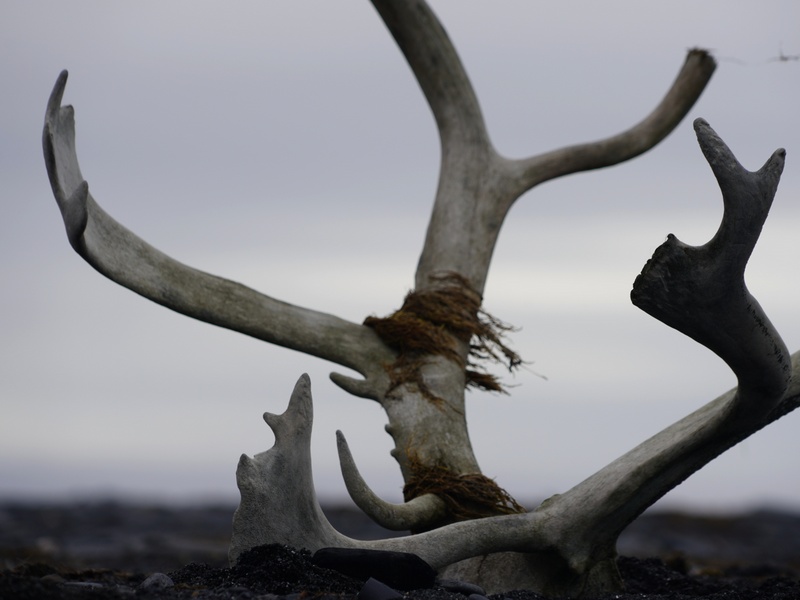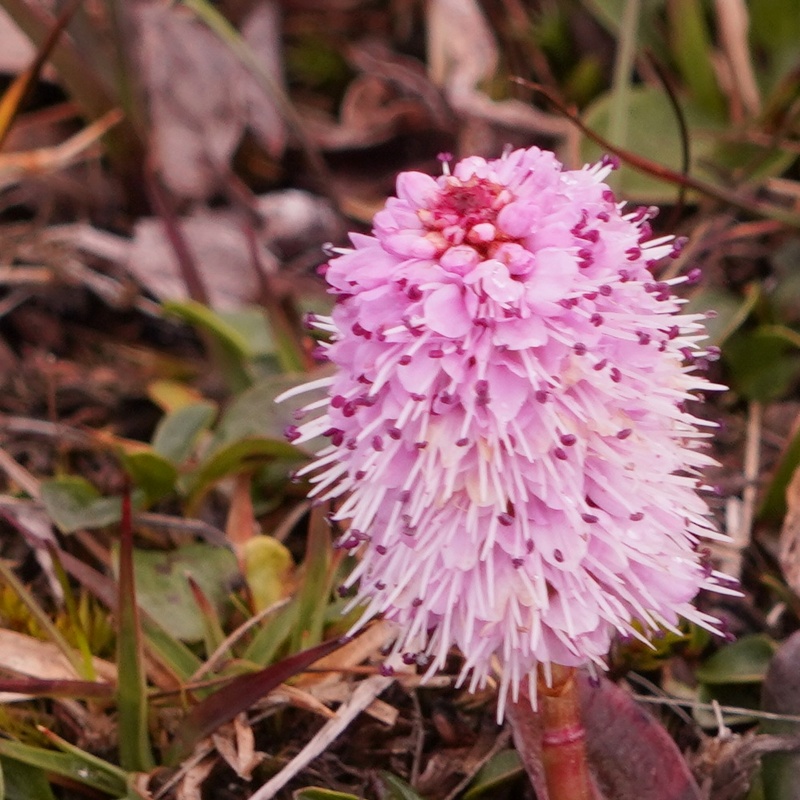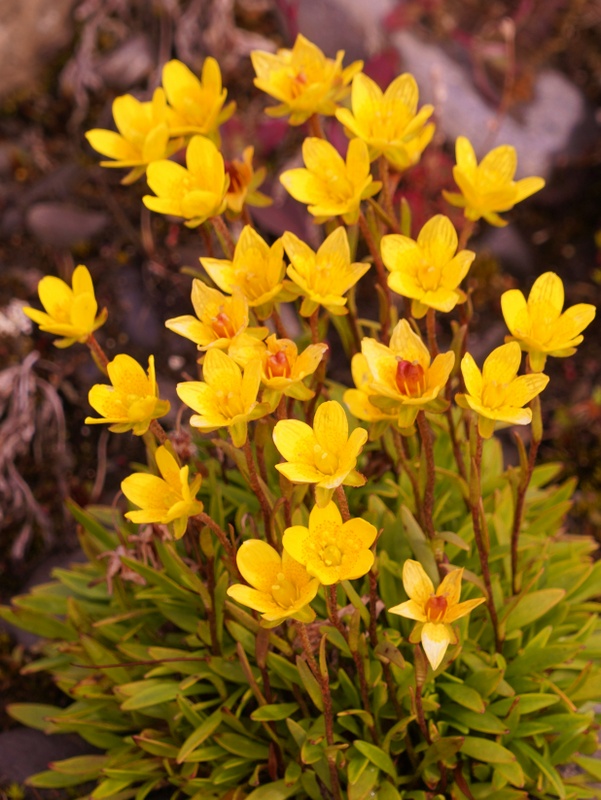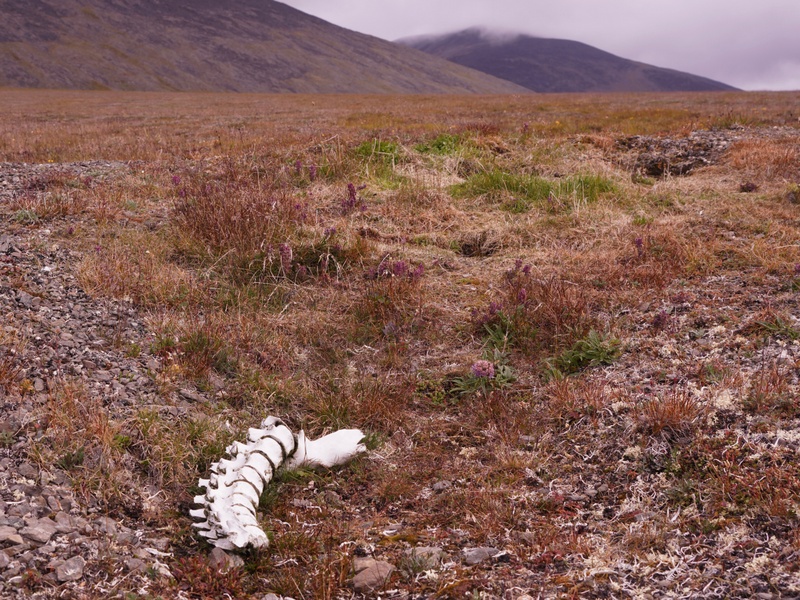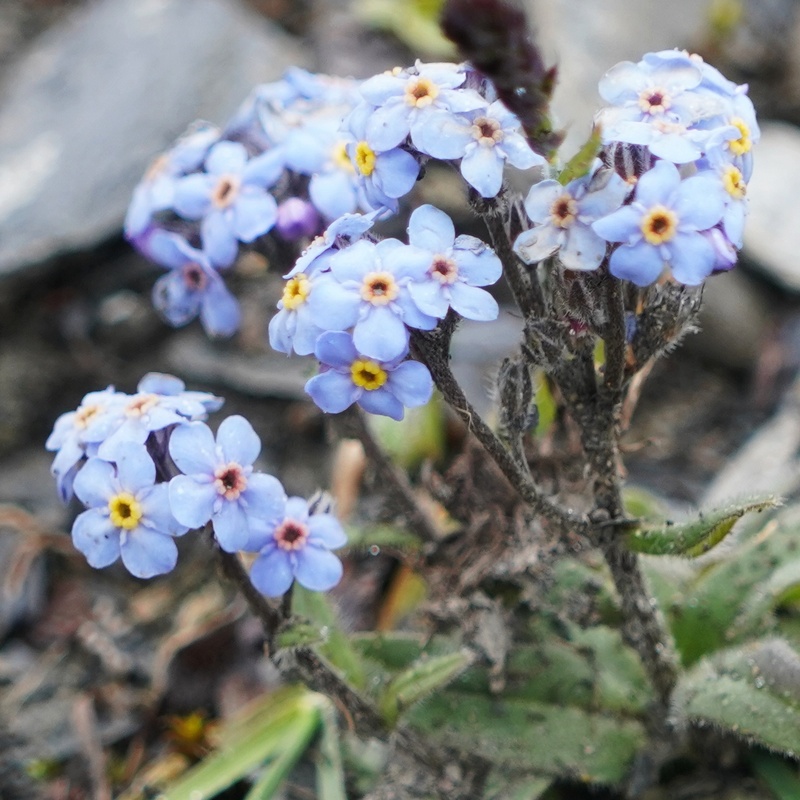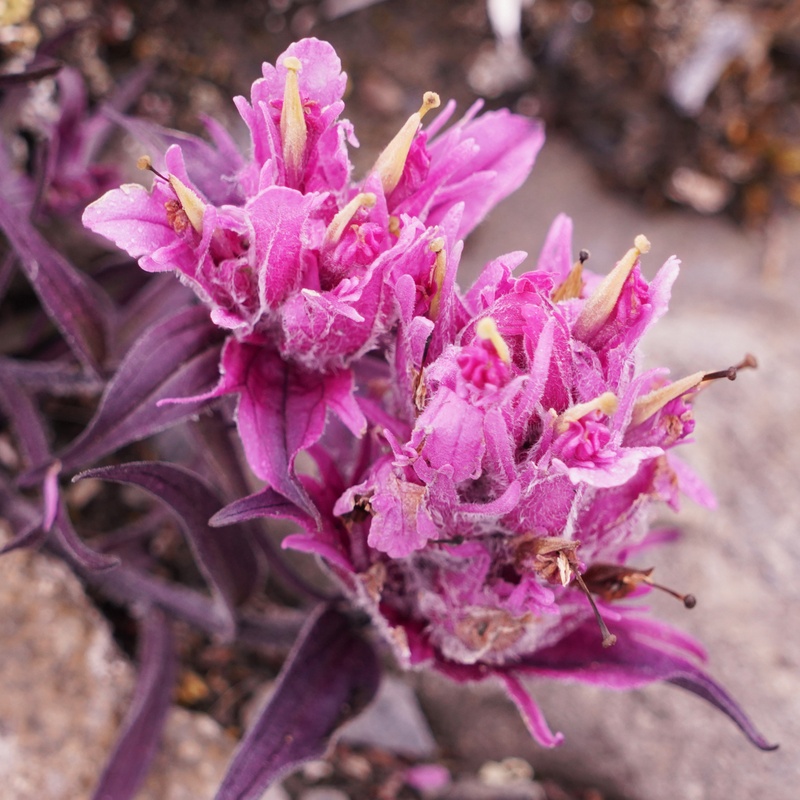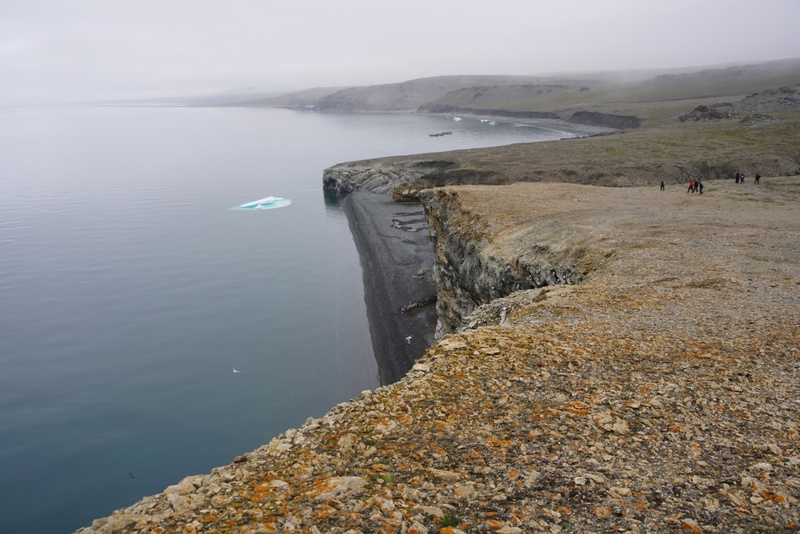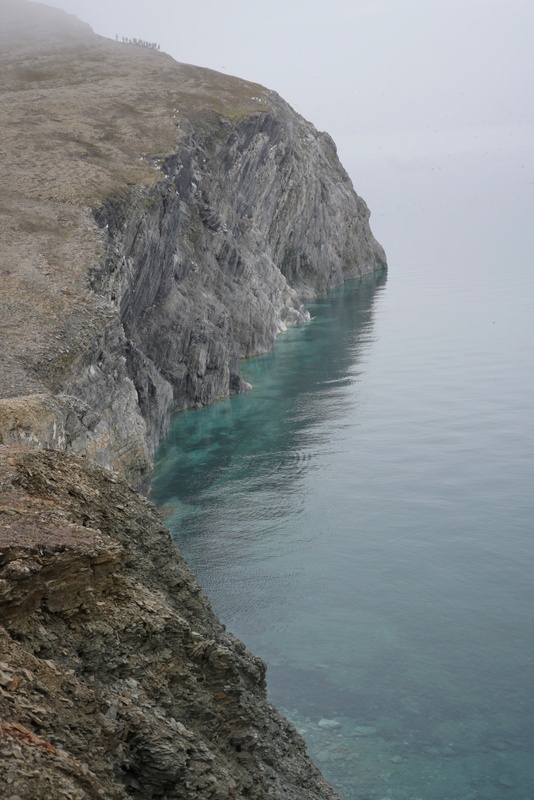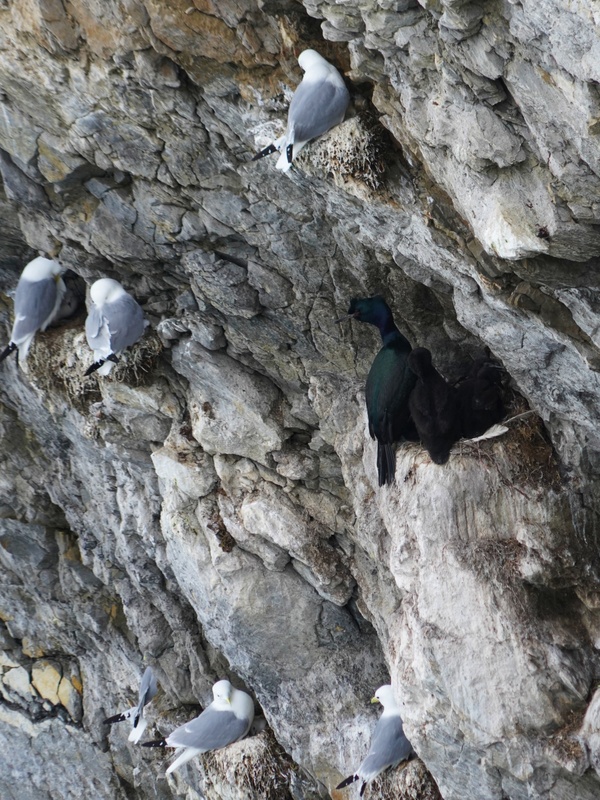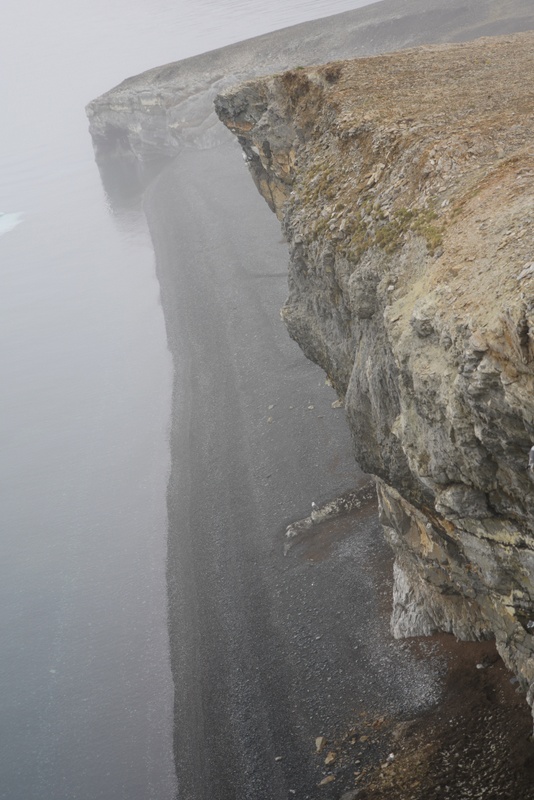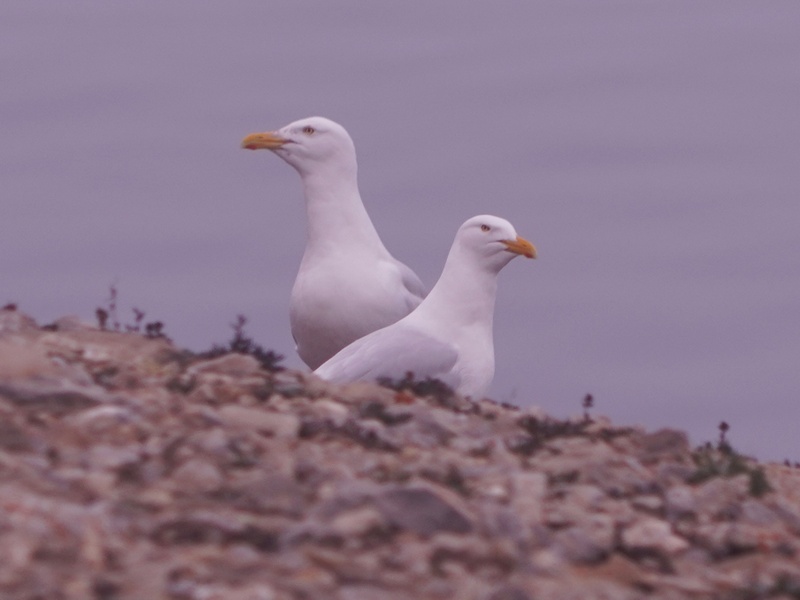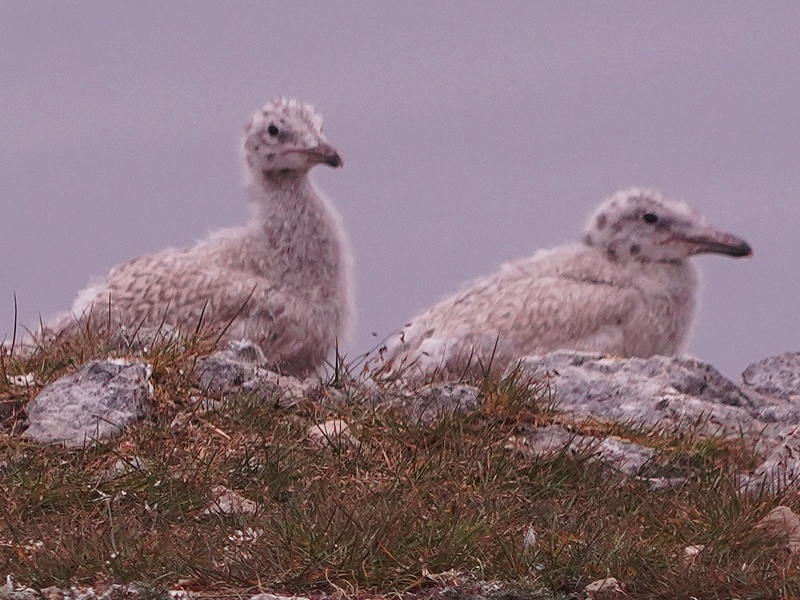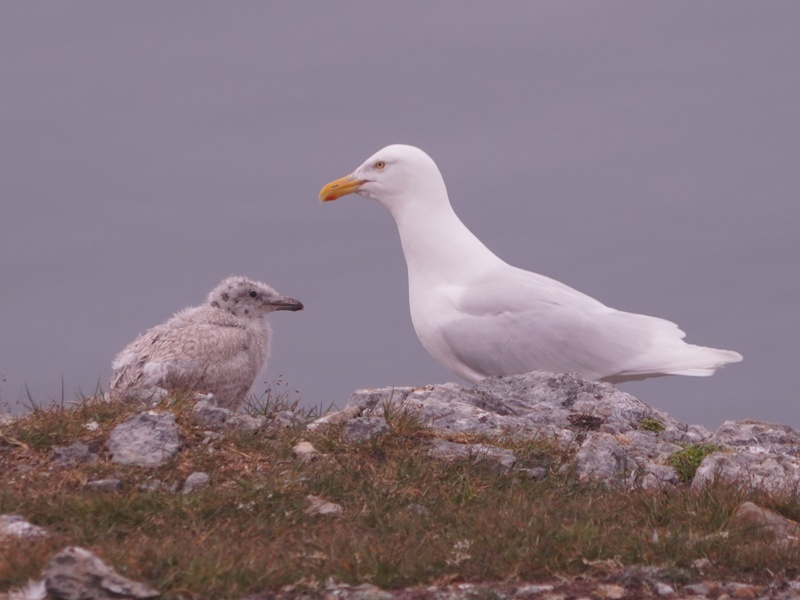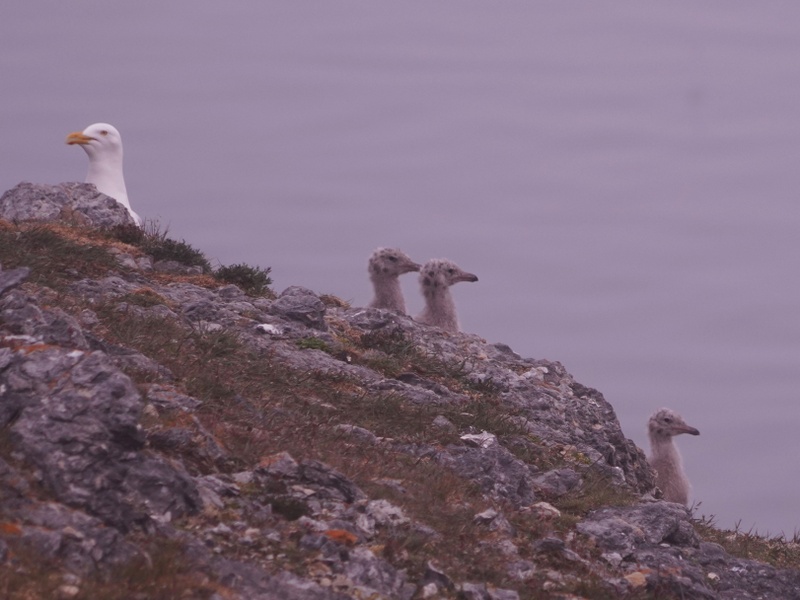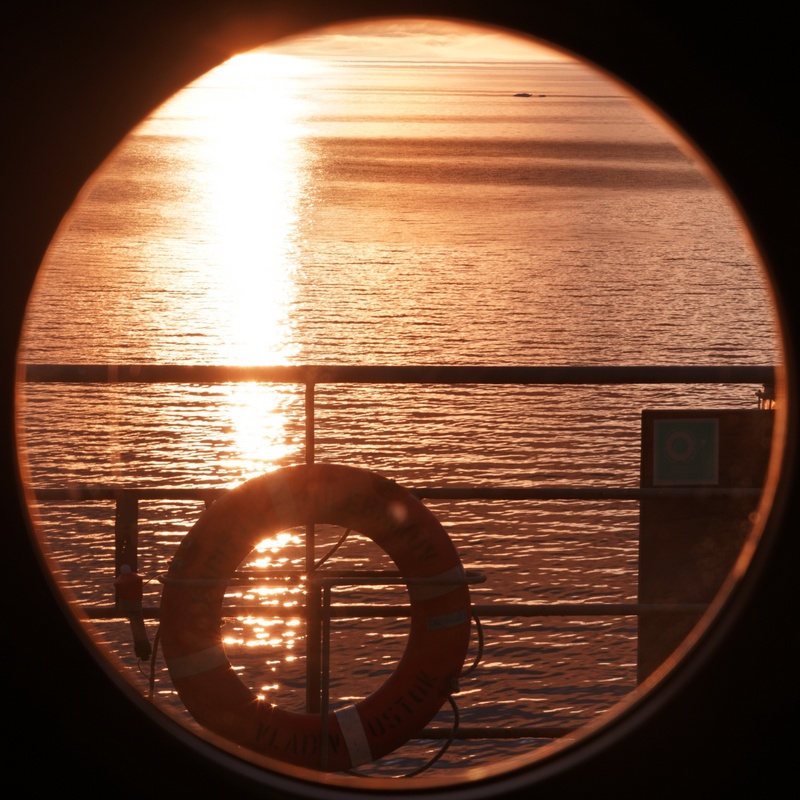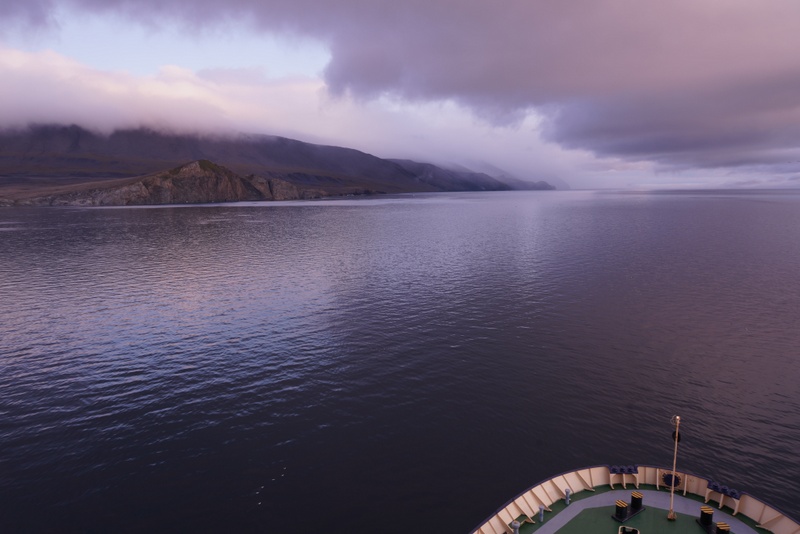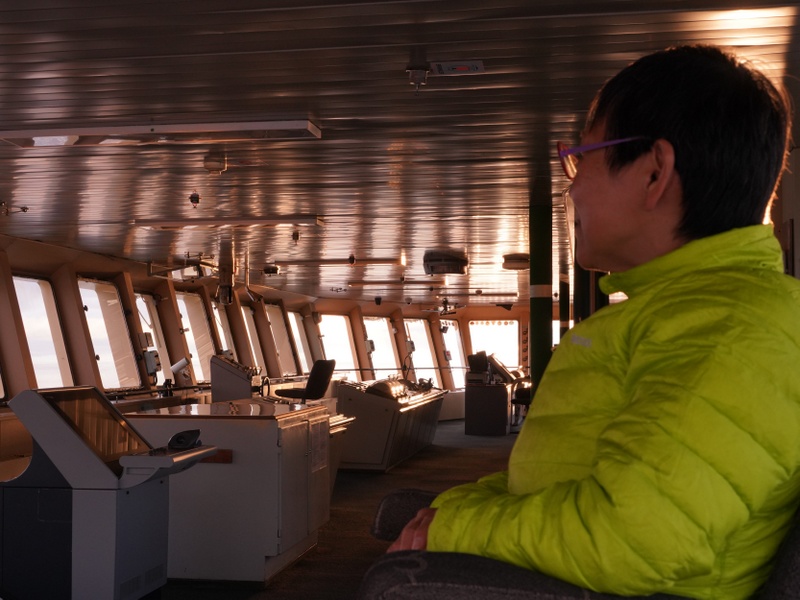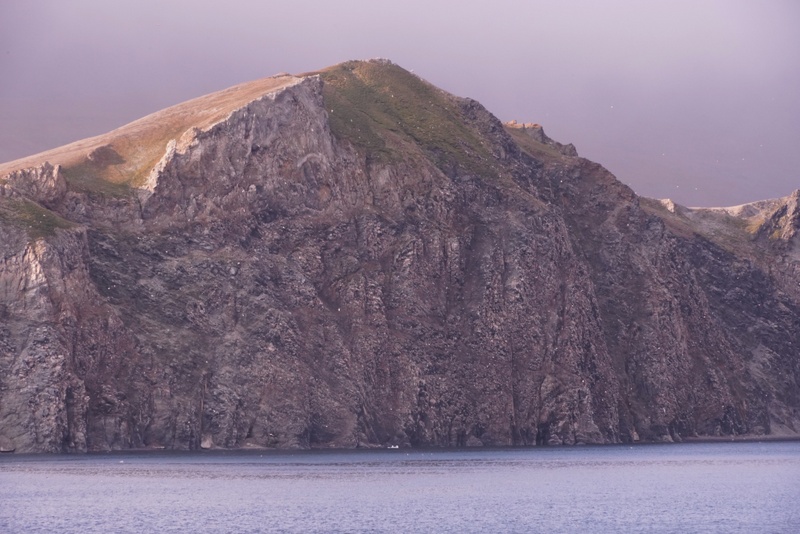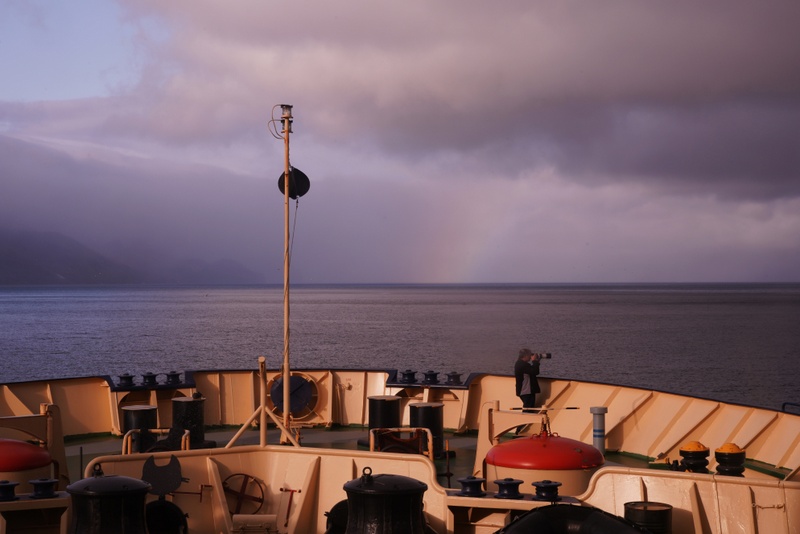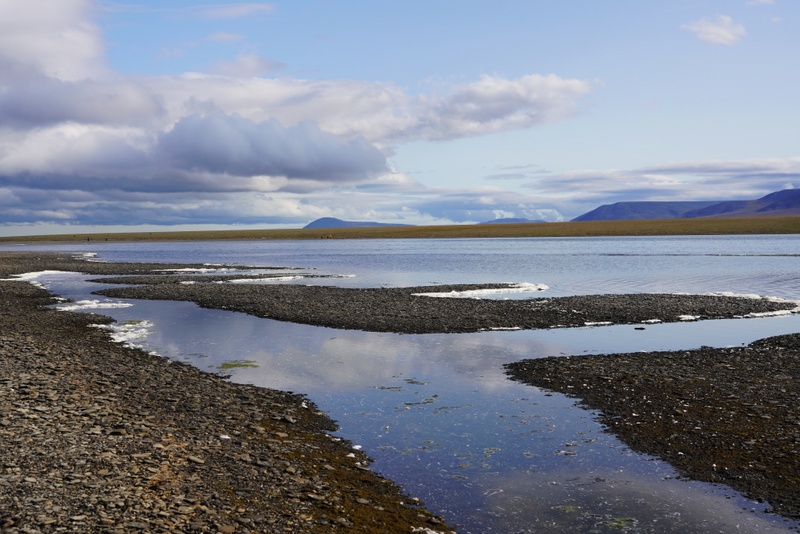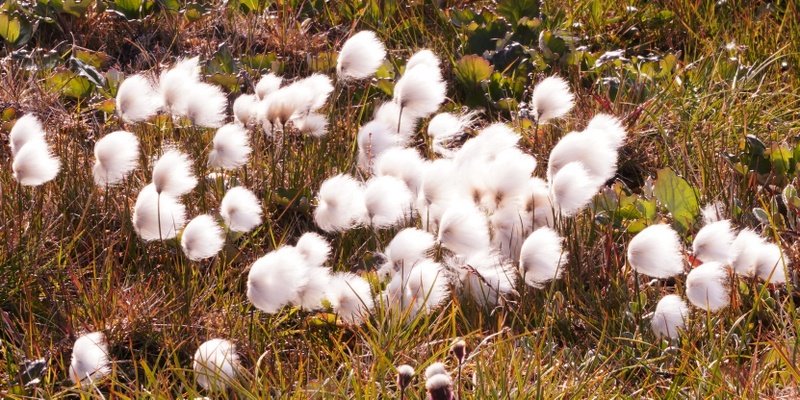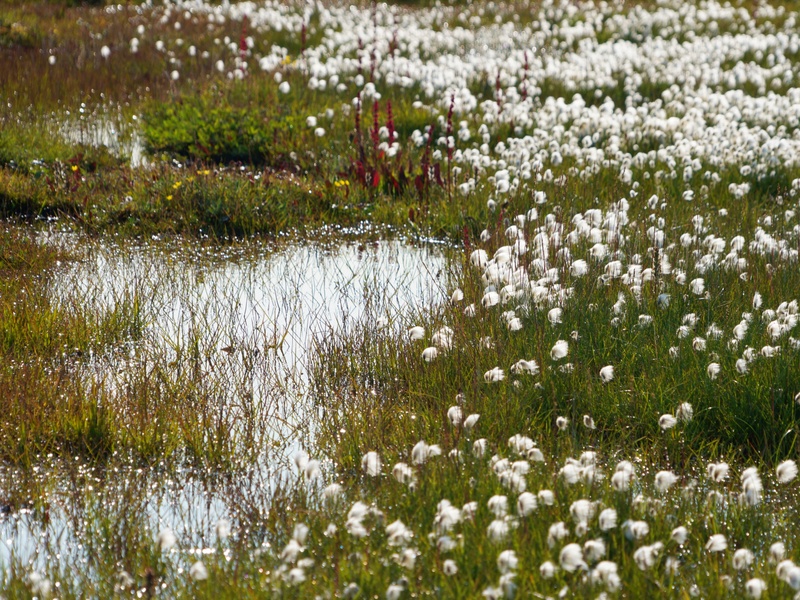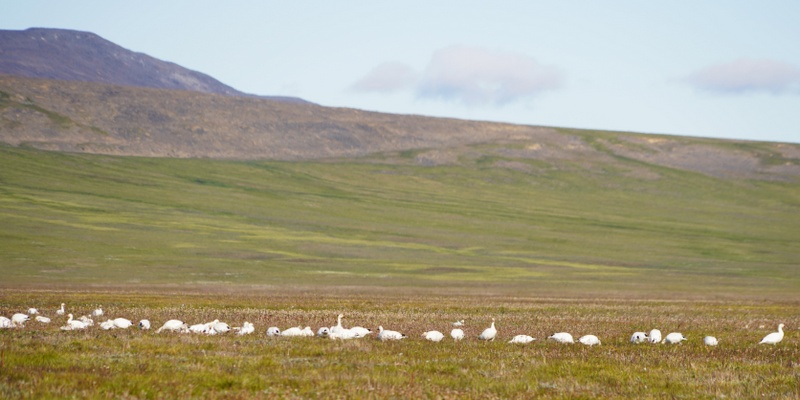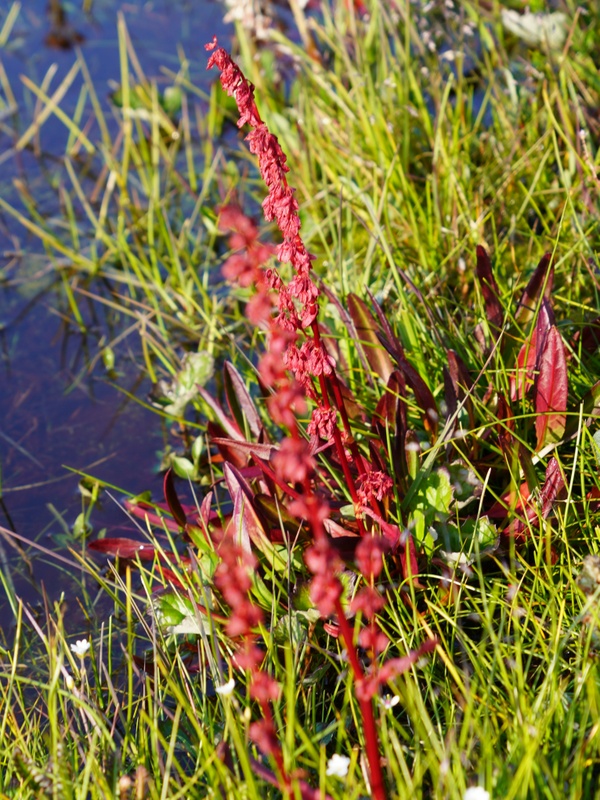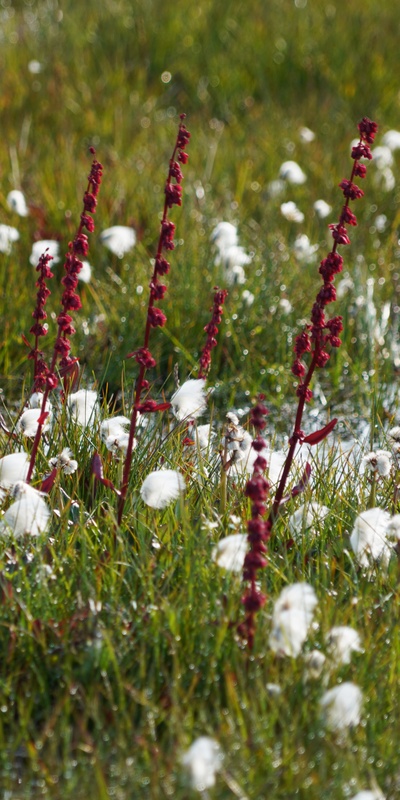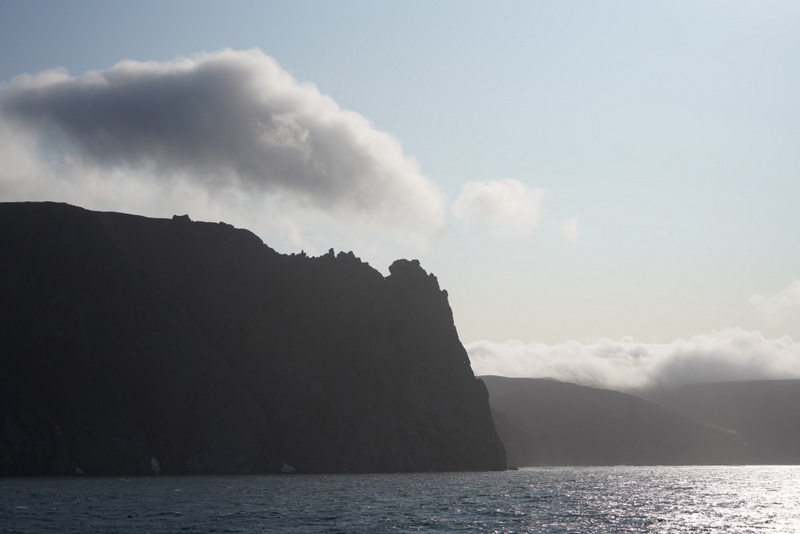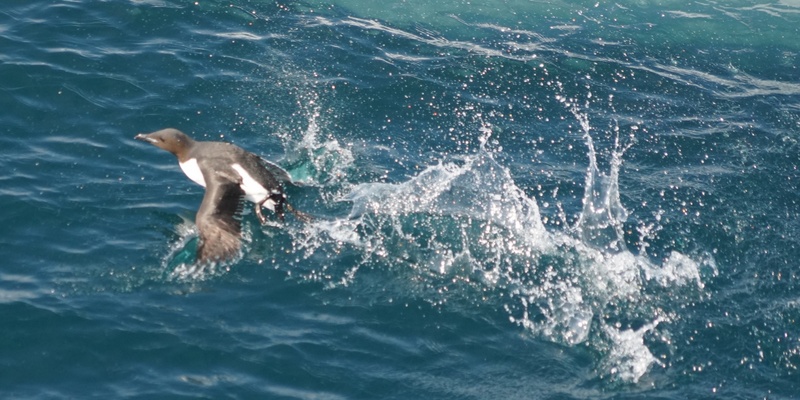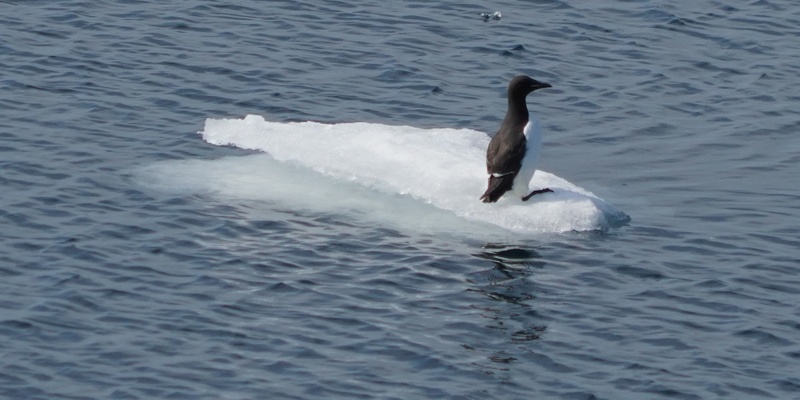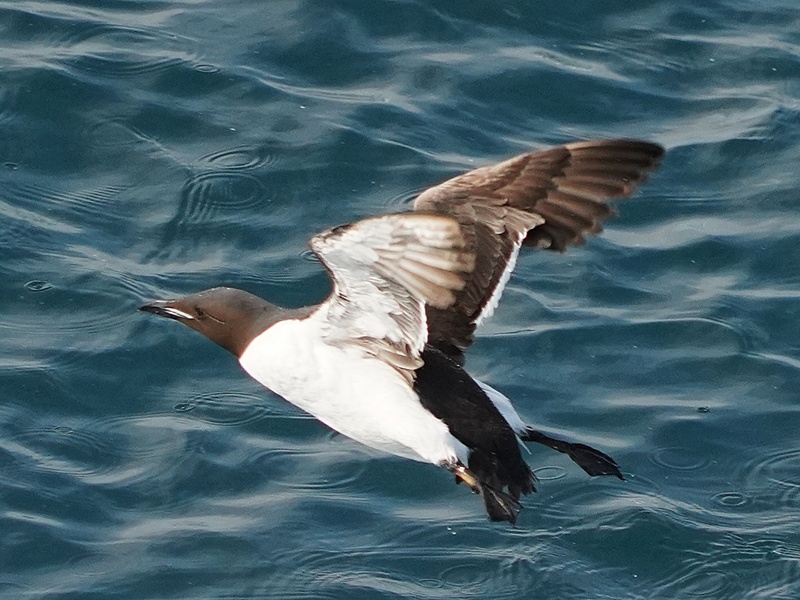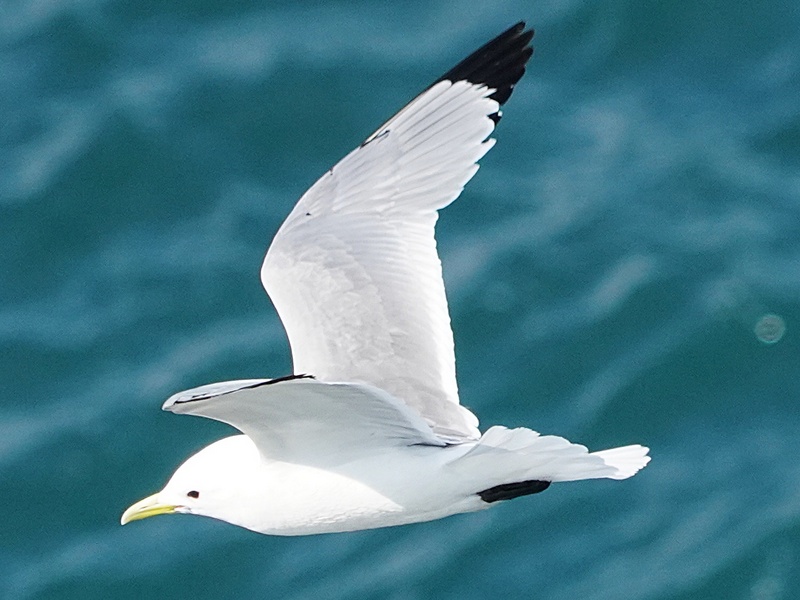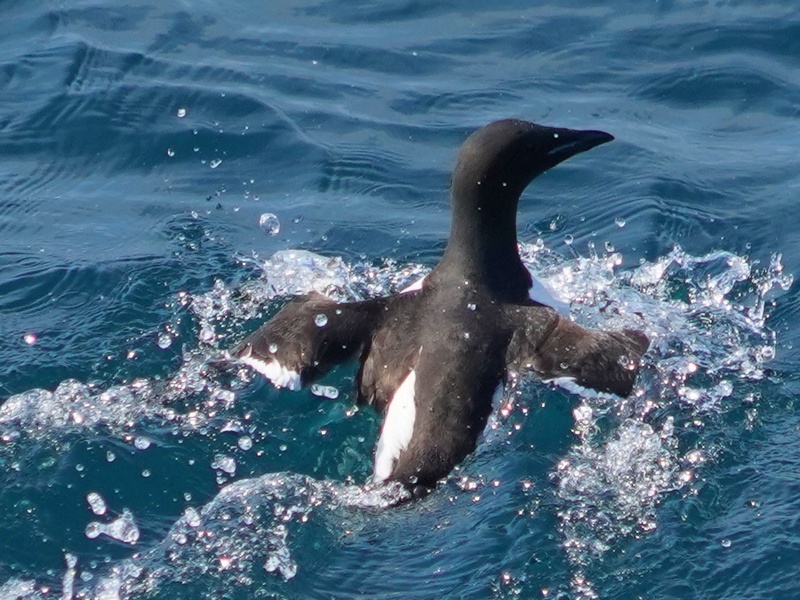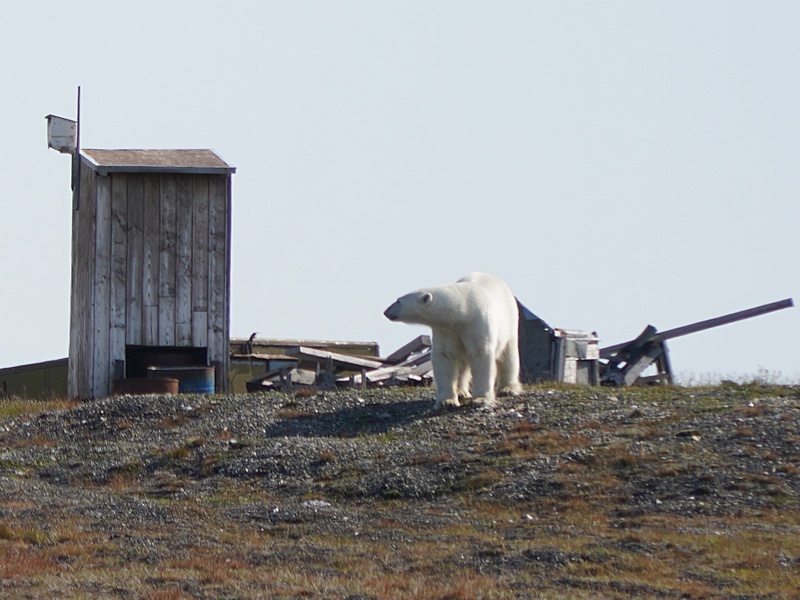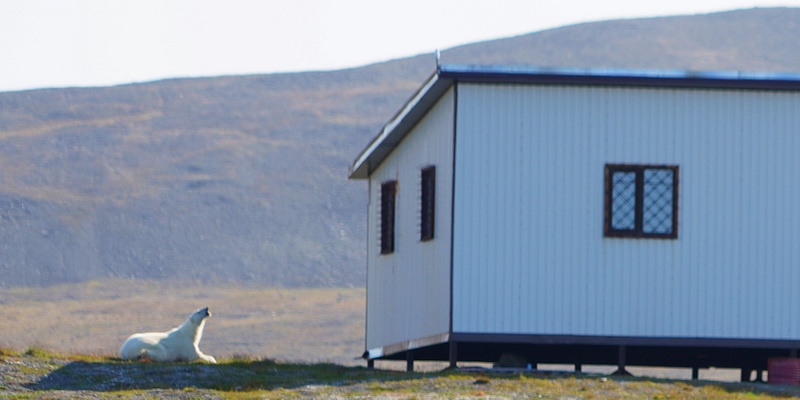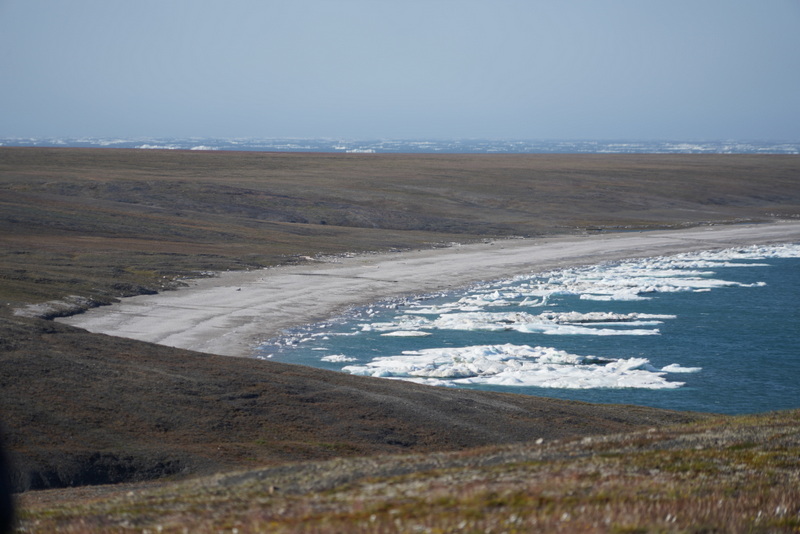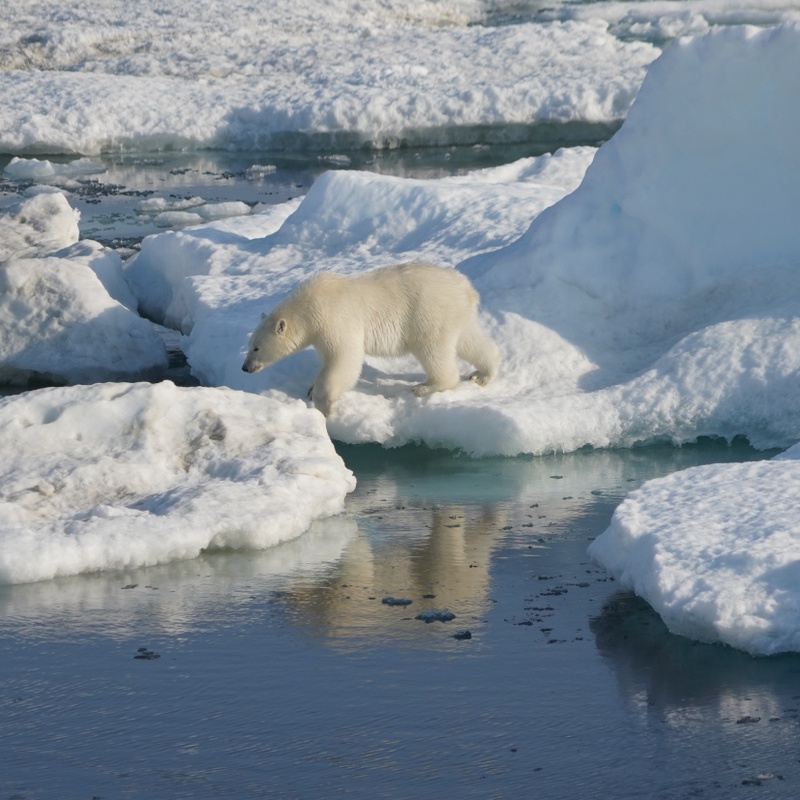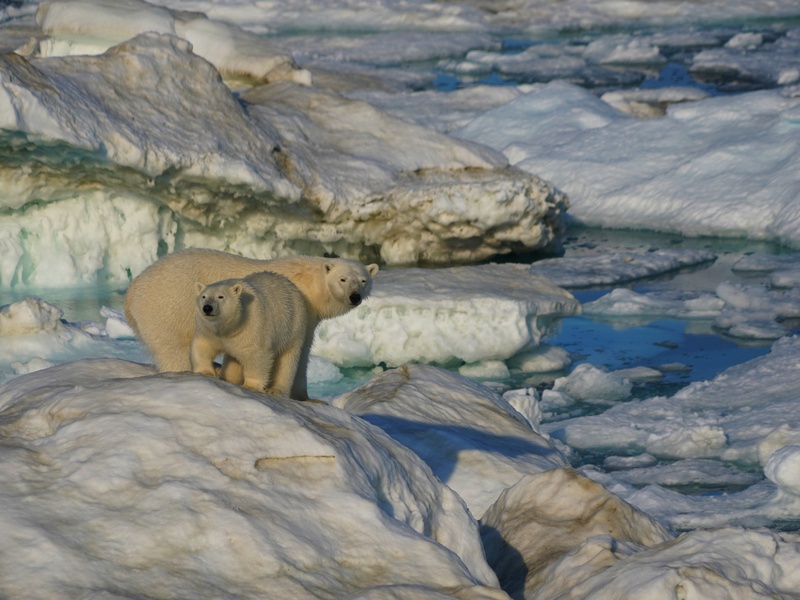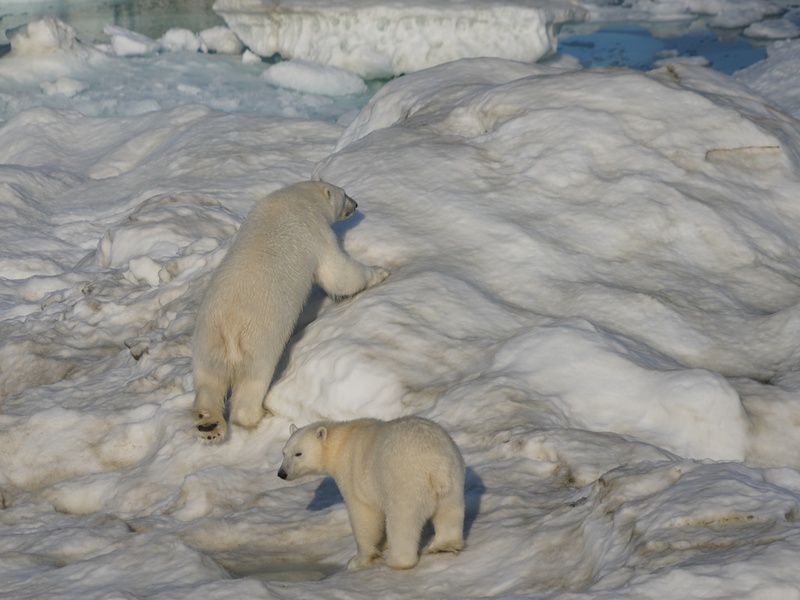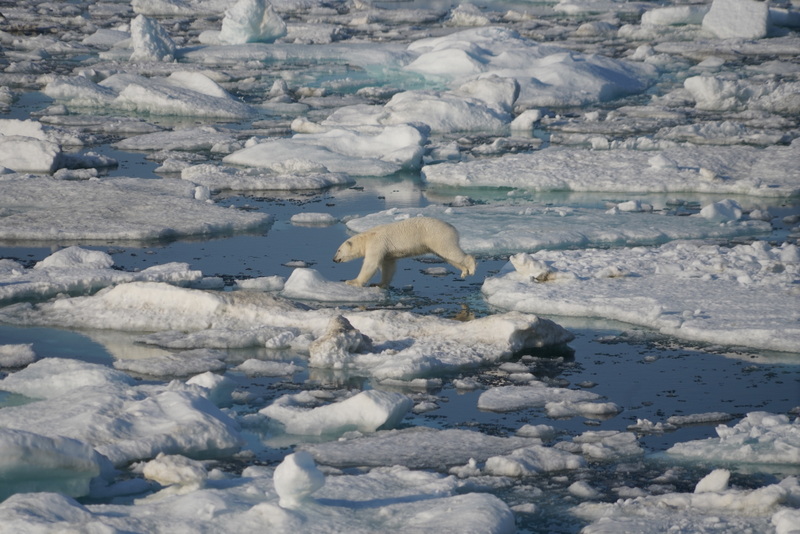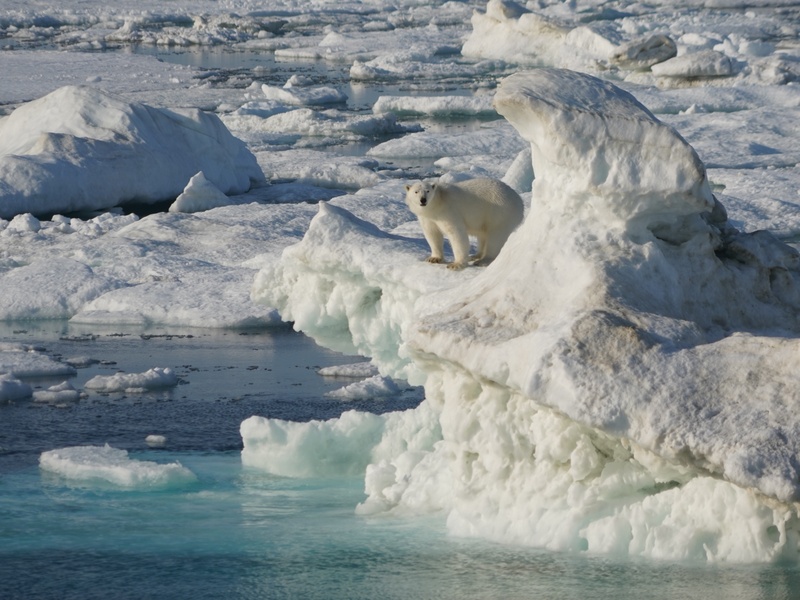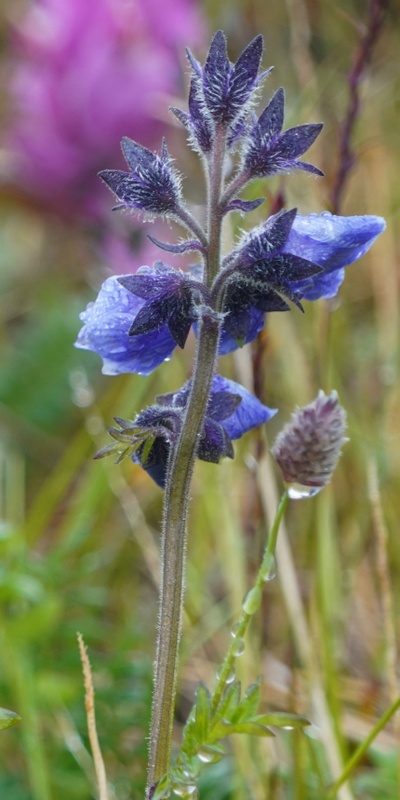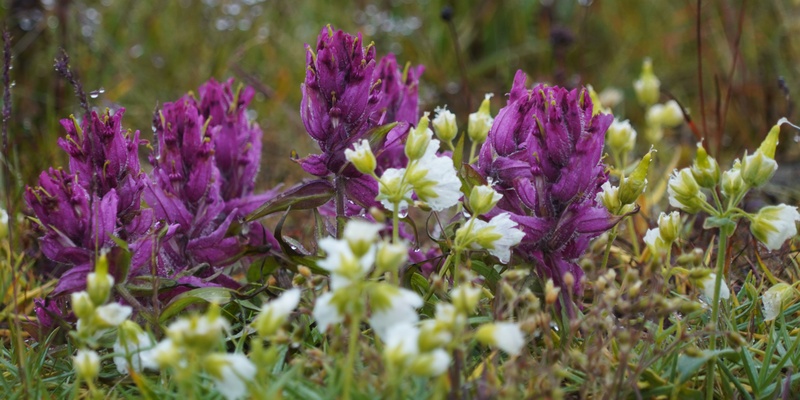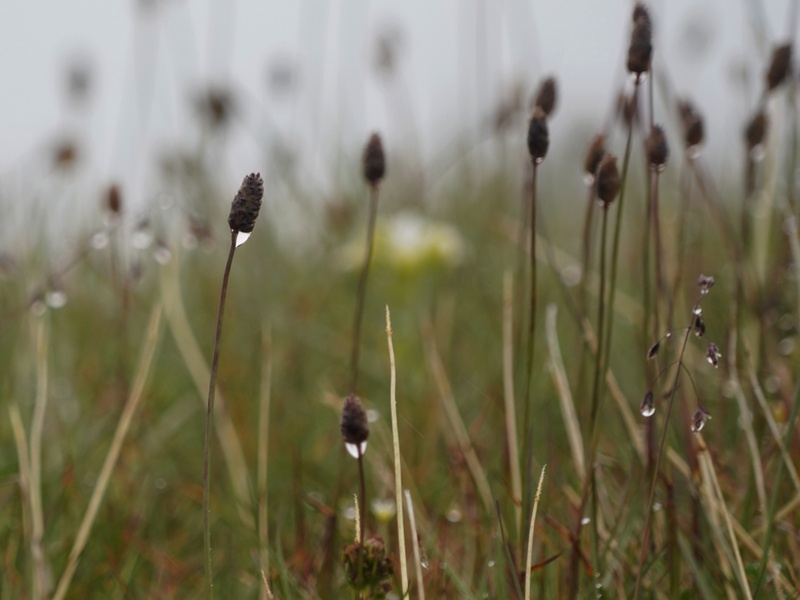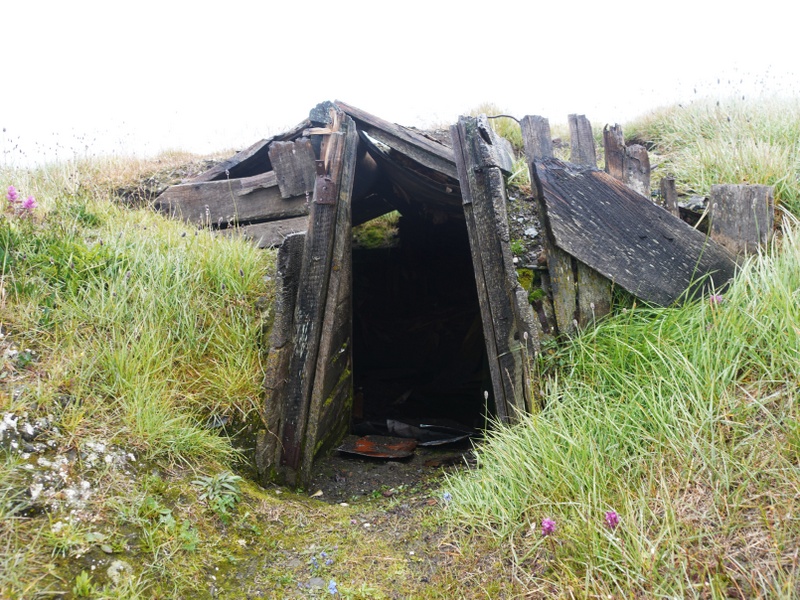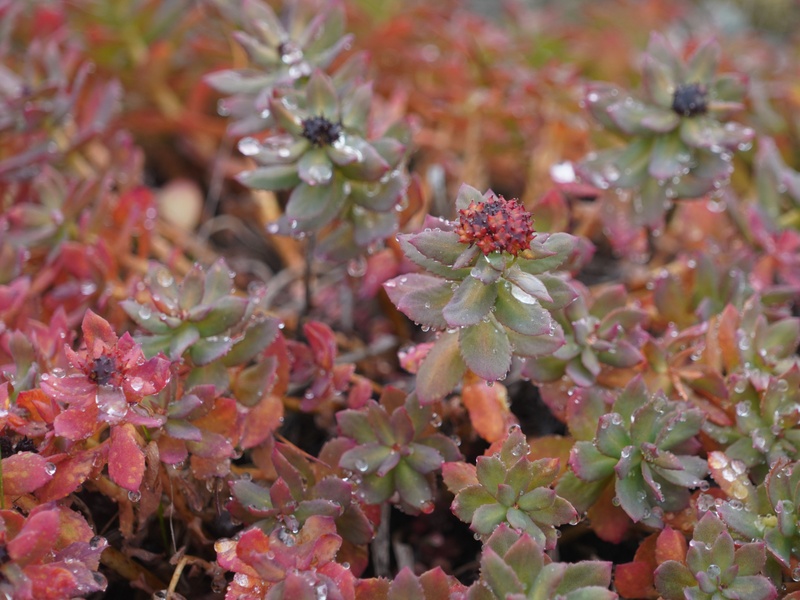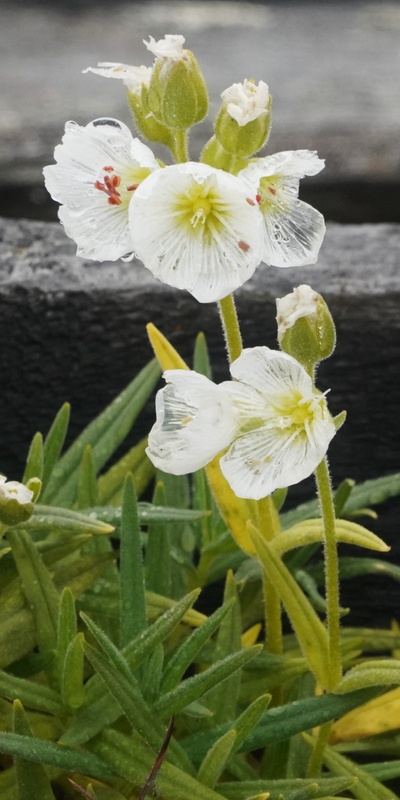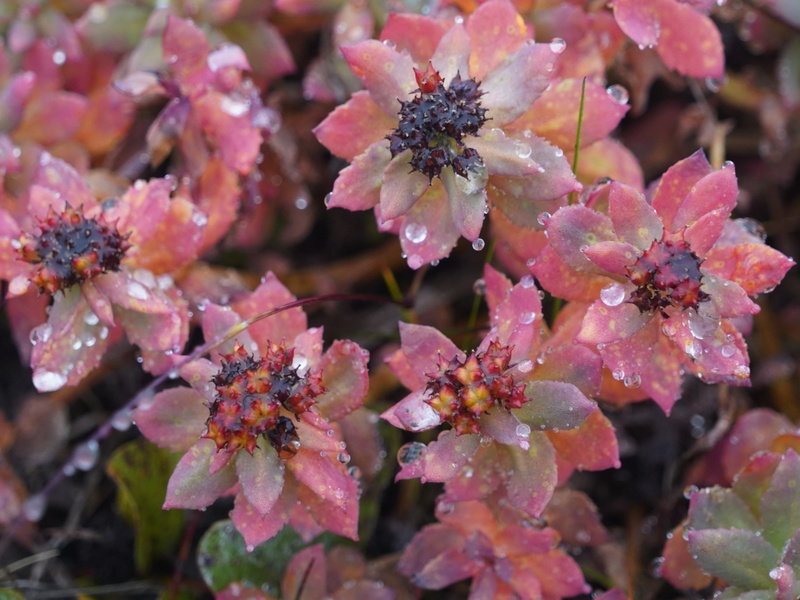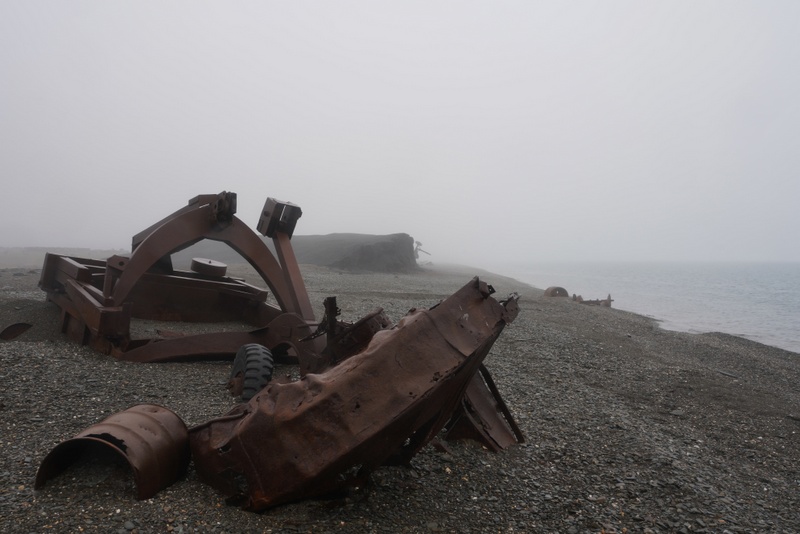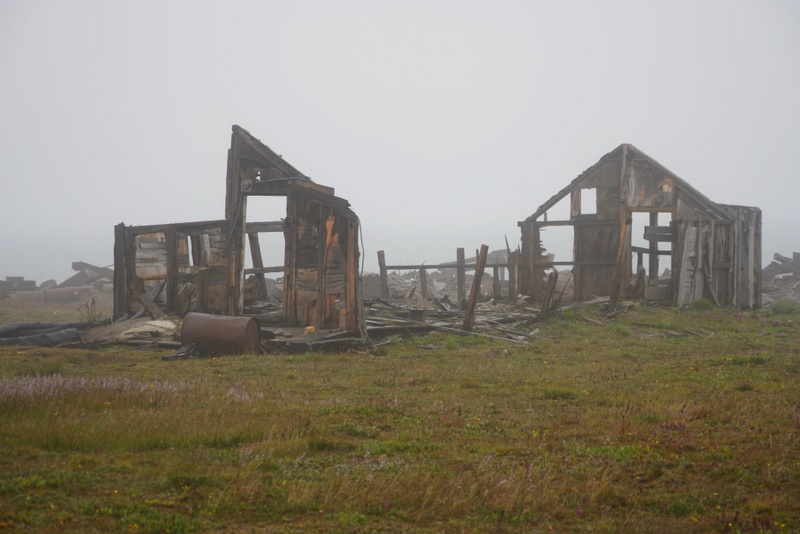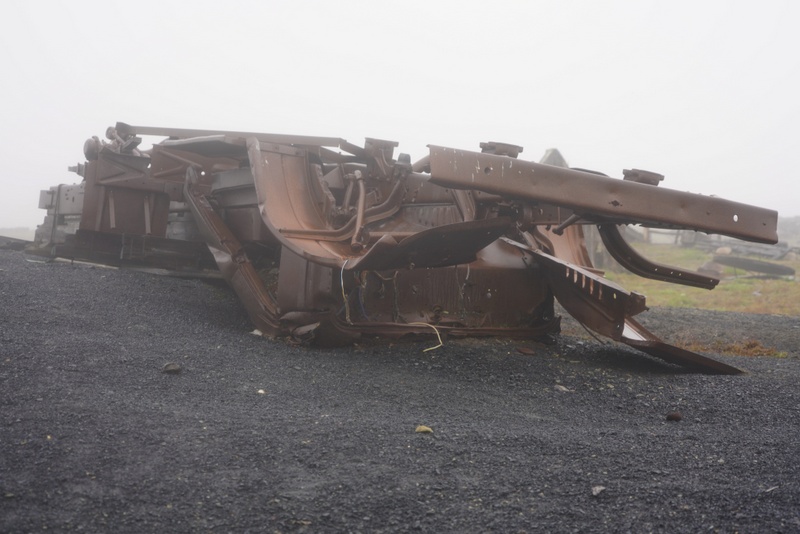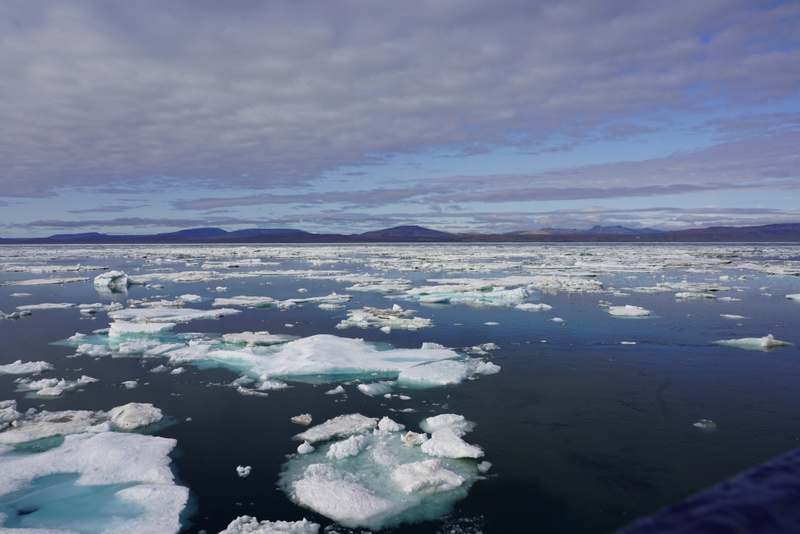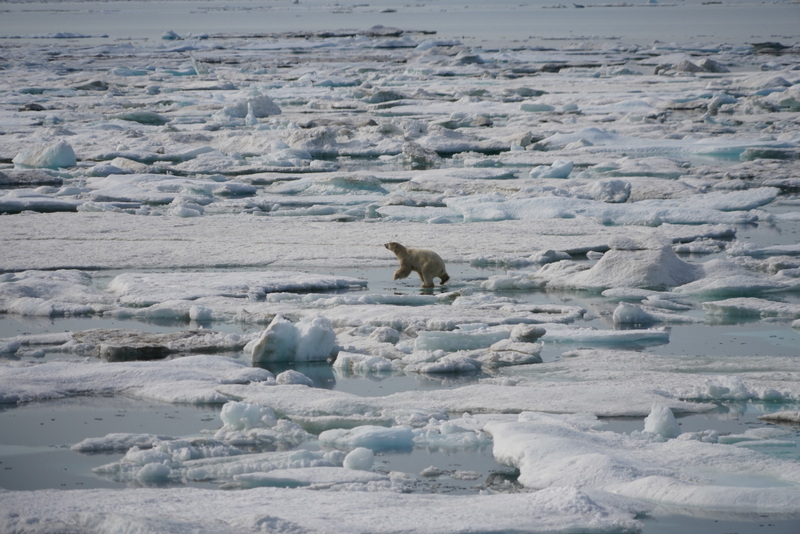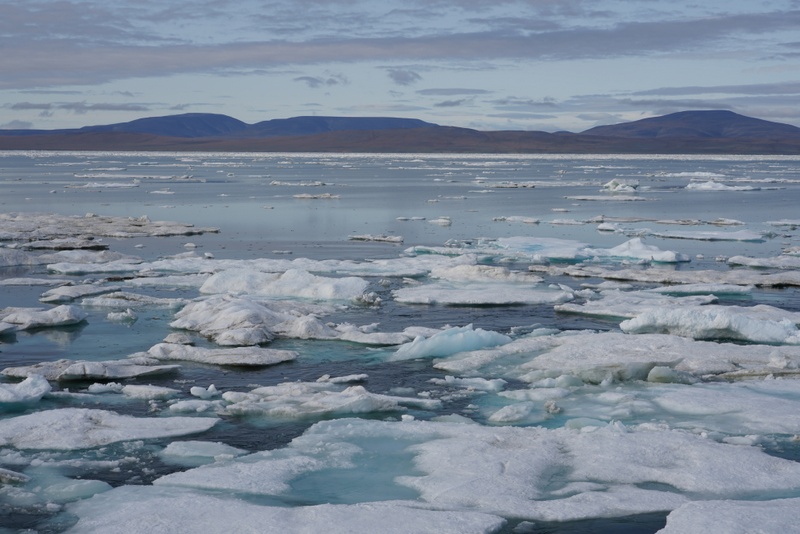Wrangel Island July 25 – 30
Wrangel Island Day 5 – Day 9
Wrangel Island with an area of 7,600 km2 is an Arctic island lying astride the 180° meridian between the Chukcki Sea and East Siberian Sea. The distance to the closest point on the mainland is 140 km. The International Date Line is displaced eastwards at this latitude to avoid the island as well as the Chukcki Peninsula on the Russian mainland. It may have been the last place on earth where woolly mammoths survived until 2,500-2,000BC. Isolated from the mainland for 6,000 years, about 500 to 1,000 mammoths lived on the island at a time.
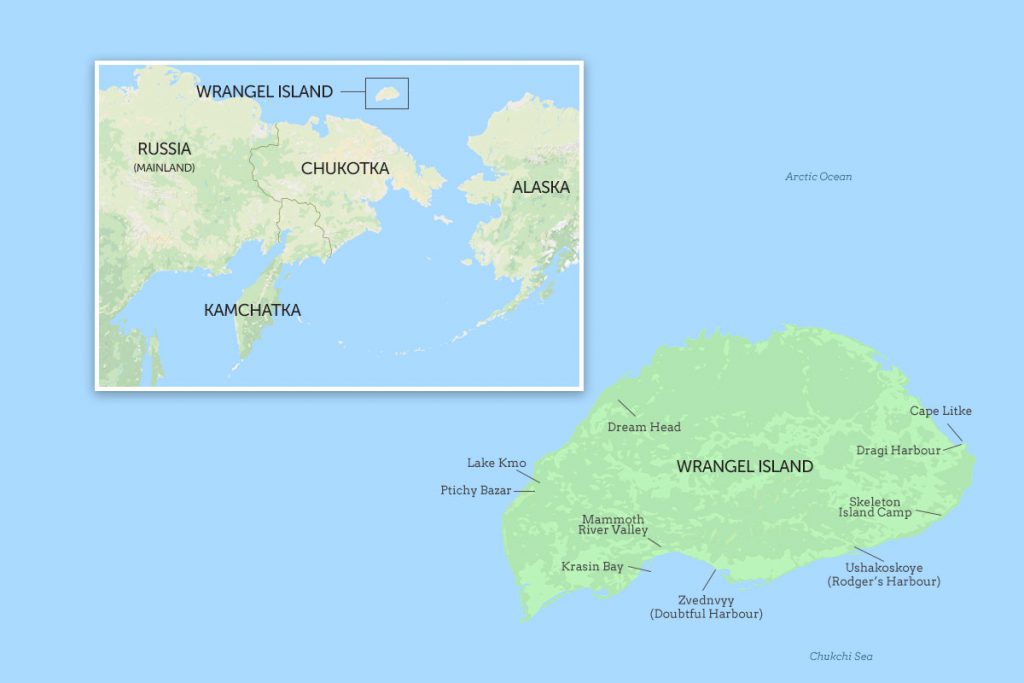
The island is a federally protected nature sanctuary administered by Russian Ministry of Natural Resources and Environment. Most of the island, the nearby Herald Island and its surrounding waters are protected and exclude practically all human activity other than for scientific purposes. Only a few rangers reside on the island year-round while a core group of some ten scientists conduct research during the summer months.
Human Settlement and Exploration
Radiocarbon dating shows the human inhabitation roughly coeval with the last mammoths on the island c. 1700 BC. The coast might have been colonized in late prehistoric and early historic times by Inuit settlers from the North America. The island was likely a way station on a trade route linking the Inuit settlement at Point Hope, Alaska with the north Siberian coast.
In 1764, Sergeant Stepan Andreyev, a Cossack claimed to have sighted the island and found evidence of its inhabitants. Eventually the island was named after Baron Ferdinand von Wrangel, who after reading Andreyev’s report and hearing Chukcki stories of land, set off an expedition (1820-1824) to discover the island, with no success. In 1849, Henry Kellett, captain of HMS Herald landed on and named it Herald Island.
Wrangel Island was first sighted by Thomas Delong in 1867. In 1879, George Delong commanding USS Jeannette, led an expedition to the North Pole and passed within sight of Wrangel Island before the boat being crushed and sunk in the vicinity of the New Siberian Islands. First landing on Wrangel Island in recorded history was made in 1881 by the crew of US revenue steamer Corwin. They landed on a beach near the mouth of Clark River. John Muir, a naturalist, christened it ‘The Land of White Bears’.
In 1914, members of the Canadian Arctic Expedition organised by Vilhjalmur Stefansson, were marooned on the island for nine months after their ship Karluk was crushed in the ice pack. The survivors were rescued after Captain Robert Barlett walked across the Chukchi Sea to Siberia to seek help. In 1921, Stefansson sent five settlers to the island in a speculative attempt to claim it for Canada. In 1923, the sole survivor, Ada Blackjack was rescued by a ship that left another party of 12 (American Charles Wells and 12 Inuit). In 1924, the Soviet deported this group without objection from the US government. In 1926, USSR reaffirmed its claim of sovereignty over the island.
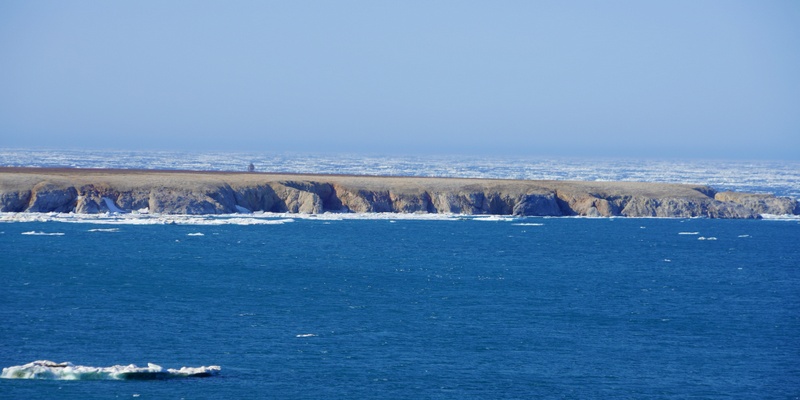
A Hotspot of Biodiversity
The island is a World Heritage Site since 2004. It boasts over 400 species of plants and is a breeding ground for polar bears (having the highest density of dens in the world) and seals, walrus and lemmings. Arctic foxes also make their home on the island. During the summer, it is visited by many types of birds. Cetaceans such as Bowhead Whales, Grey Whales and Beluga can be seen close to shore. Domestic reindeer and musk ox were introduced in the 1950s and 1975 respectively. The number of reindeer is managed at around 1,000 while the population of musk ox has grown from 20 to over 1,500.
Day 5: Friday July 26 180 Meridian & Cape Blossom
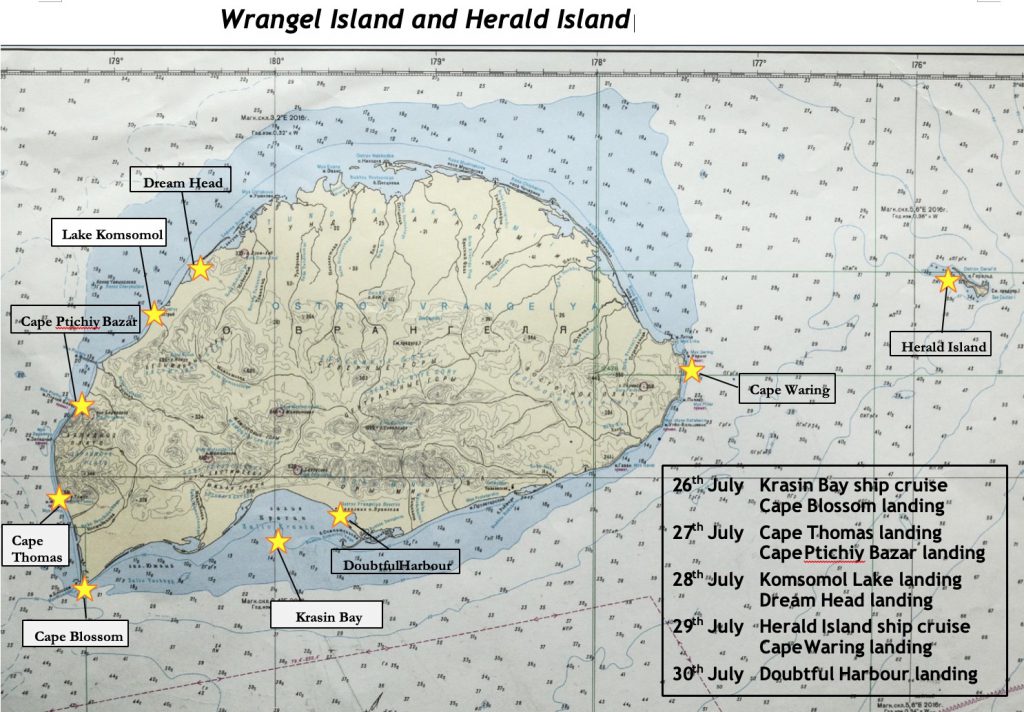
Nathan’s plan today would be to make our first landing in Wrangel Island at Doubtful Harbour where five passengers including my cabin mate Gail would get off for a 3 day- 2 night overland adventure.
The island was within sight early in a gorgeous bright and sunny morning. I got up around 4 am. After spending a while in the library, I went outside to enjoy the stunning scenery with ice surrounding the ship.
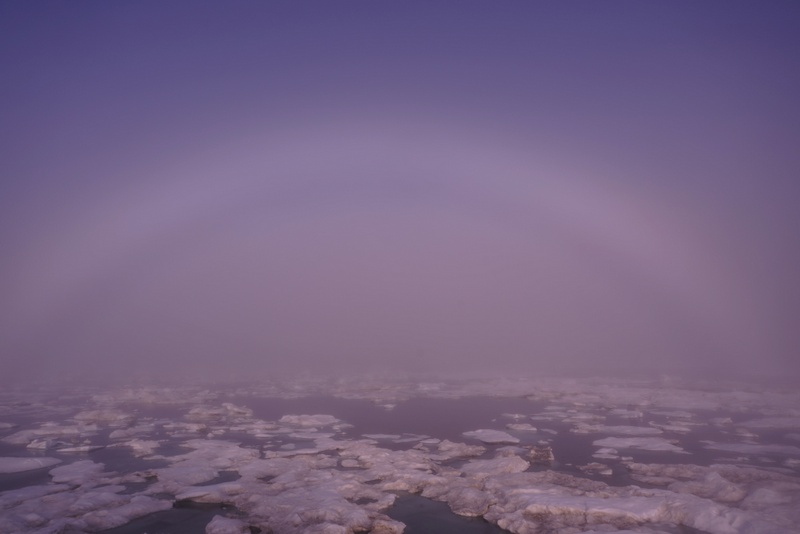
Around 5 am, I heard an announcement about ‘Polar Bear on the starboard side’. I was at the right spot at the right time! But it was too far for a good snapshot.
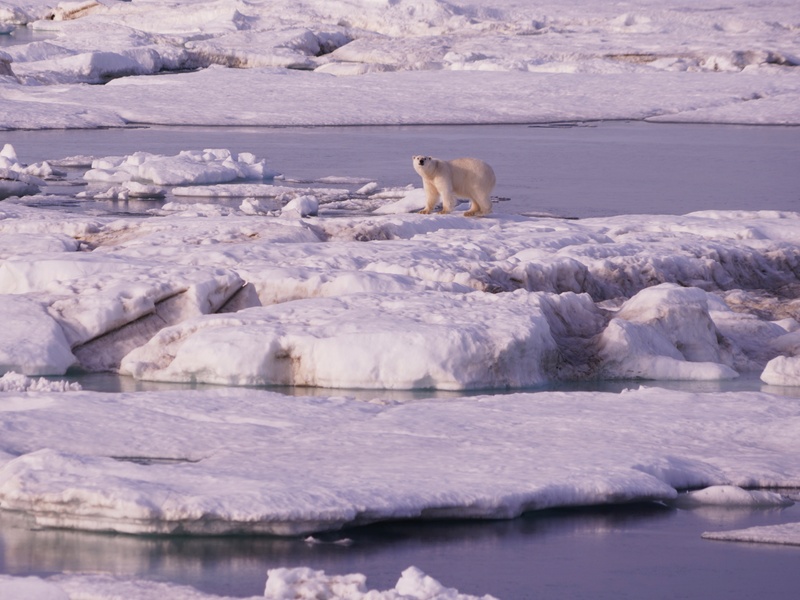
Soon, another bear appeared on the port side. I followed the crowd and was delighted to watch it coming close to the ship. The light was perfect and the sea ice provided a magnificent backdrop. Shortly afterward, we spotted a mom and two cub in a distance.
Then a big bear with a very dirty brown coat appeared. (I wonder whether it is a hybrid!) It walked towards the boat and was finally only ten metres from us!
A second mom and two cubs were soon spotted in a distance. The ship was almost stationary now so that we could get a better view of the bears.
Then three more bears – a mom and two cubs made a grand entrance. One cub was particularly curious and ventured towards the ship. Mom and the other cub followed. Finally, they stood on an ice floe right next to the ship. As all the spots along the bow were taken, I laid on my belly so that I could take a photo through one of the holes!
It’s a like a dream to watch the party of three jumping and swimming from one ice floe to another, they rolled in the ice to dry their fur and laid completely flat with as much of their bellies on the ice as possible. They look so cute, healthy and beautiful.
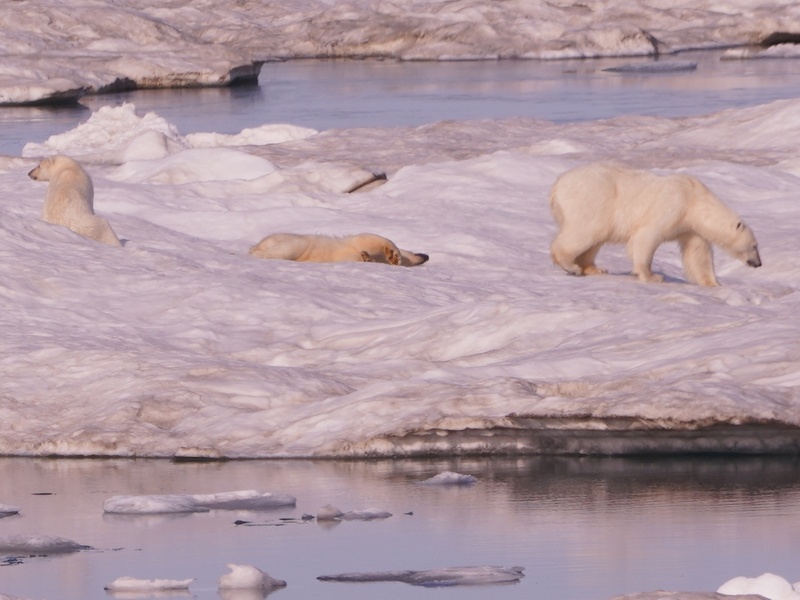
Before breakfast at 7am, we had already seen 12 polar bears. Some passengers claimed to spot three more bears (???) in great distance.
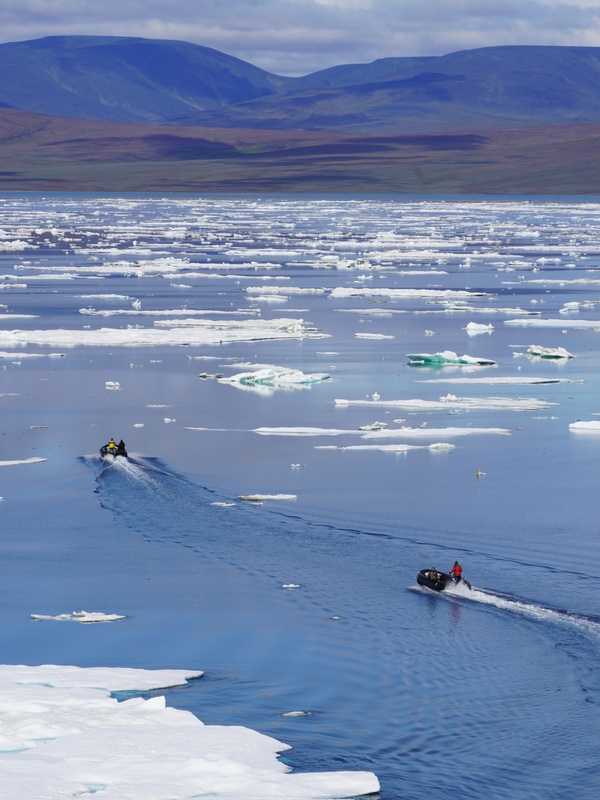
As the ice condition did not allow a landing as scheduled, the ship only picked up the rangers and dropped off the five overland passengers. Gail was one of the lucky one to go on the expedition. She was excited and I much looked forward to hearing about her adventure.
After picking up the rangers, we sailed on and left the ice behind. In the morning, Joe gave a most remarkable lecture on ‘Perspectives on Composition in Landscape Photography’. He is slim, passionate, soft-spoken and scholarly. His well-organised lecture was captivating: rich in content, systematic, poetic and philosophical in his approach. I learn something though I remain a poor student.
I started to lose count of the number of bears I saw and when. Anyway, it was fantastic to spot and watch a bear swimming far away. It soon disappeared.
Before long, another big female bear with a curious look arrived: it stayed with the ship for some 20 minutes.
In the afternoon, we had an informative lecture by Samuel on ‘The Life and Times of Polar Bears’.
In the late afternoon, Nathan announced an unexpected landing at Cape Blossom at the very south-western corner of Wrangel Island on a vast tawny tundra plain. It is a historic spot where in March 1914, Captain Bartlett and the Yupik hunter Kataktovik began a journey to Siberia to fetch help for the crew of the Karluk stranded on the island.
My first impression of the wind-swept beach littered with rusty barrels and driftwood, was eerie and melancholic. The two ramshackle huts that are used by walrus and bear researchers occasionally, are in poor condition. I wonder when it was lived in last time.
We found some hummocks on the beach. Created when ice floes collide and overlap each other due to wind, tide and current, they provide an interesting frame for my first photo of our ship.
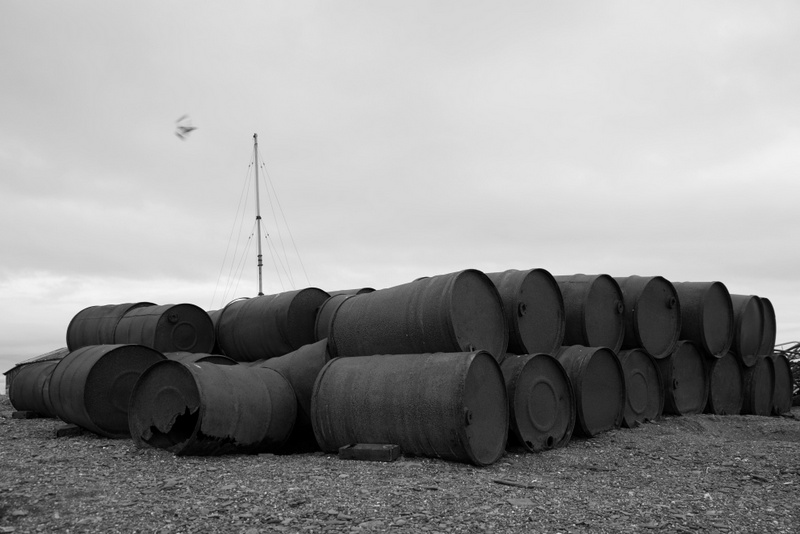
I enjoyed strolling aimlessly on the beach. The expedition team spotted a distant bear at the foot of the hill and some musk oxen on the hillside. Being a poor observer, I did not spot any of them. I took the last boat back to the ship.
Once aboard, one of the rangers gave a briefing through a translator before dinner. I was exhausted and hardly remembered what was said! As Gail was on the island, I had the cabin for two nights!
Polar Bear Count for the day: 18 & for the trip: 21.
Day 6: Saturday July 27 Cape Thomas 70°56.340’N 178°39.885’E
& Ptichiy Bazar
After an early breakfast, I got ready by 8:30am for the first zodiacs to Cape Thomas which was named after an American whaler who was a crew member on the ship under the command of Thomas Delong in 1867. At the Cape, the Russian have erected a memorial to the Russian icebreaker Vaigach whose crew landed here in 1911 and erected a navigational beacon.
It was foggy. When we were approaching the beach, we saw a Grey Whale feeding close to the shore.
Once ashore, we were split into three groups according to the distance of the walk. I joined the medium group and had an enjoyable time looking at an expansive plain bounded by low-rising hills in a distance.
Those with keen eyes spotted Snowy Owl, Pomerine and Long-tailed Skua, Lemming, two Polar Bears etc. I only managed to see the bears, the Plover and Snow Bunting.
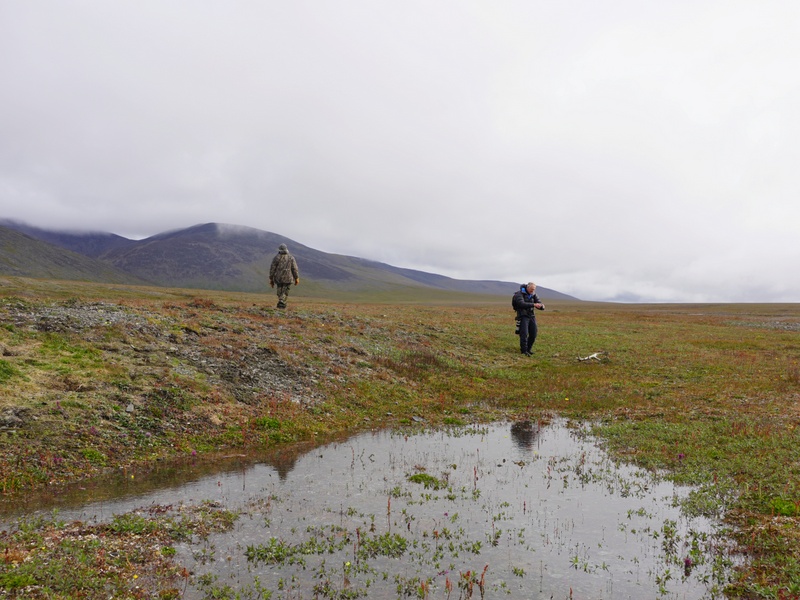
Always had a bear guard (the person looking at the mountain) with the group
We were back on the ship for lunch and were excited to know we would have a second landing at Ptichiy Bazar.
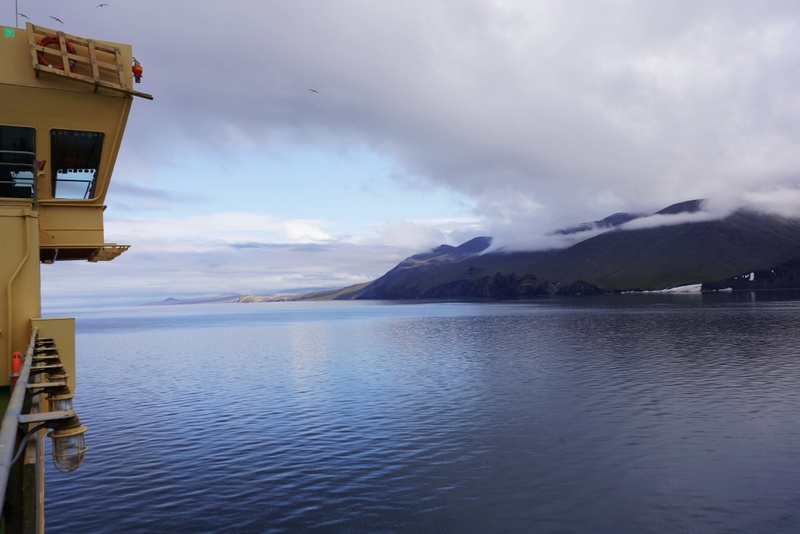
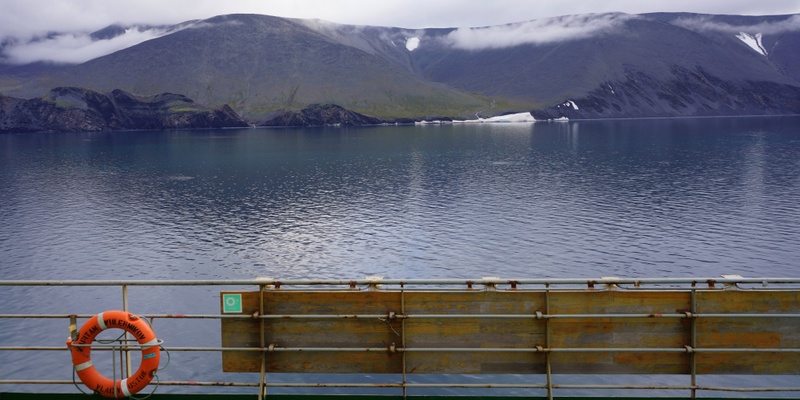
While on the way, we spotted more Polar Bears. But the star of the today was the walrus which laid lazily on a large piece of ice. Our captain slowed the ship down. But the walrus soon abandoned their positions. We thought the show was over.
We were mistaken. The water was crystal-clear. I was at the bow of the ship when 20-30 walrus speeding towards the ship. These curious creatures have come to check us out!
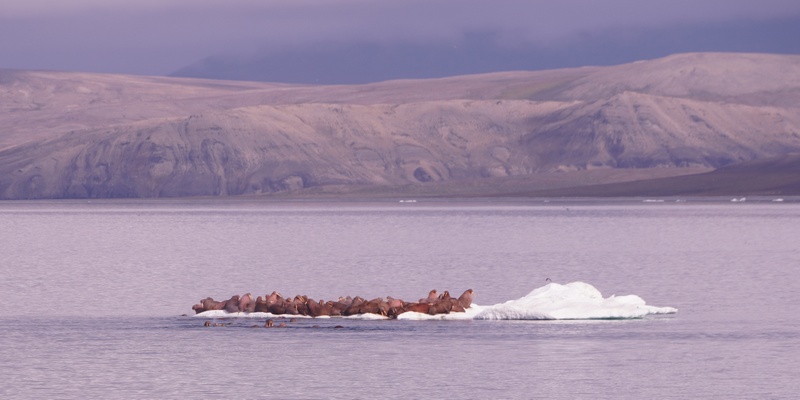

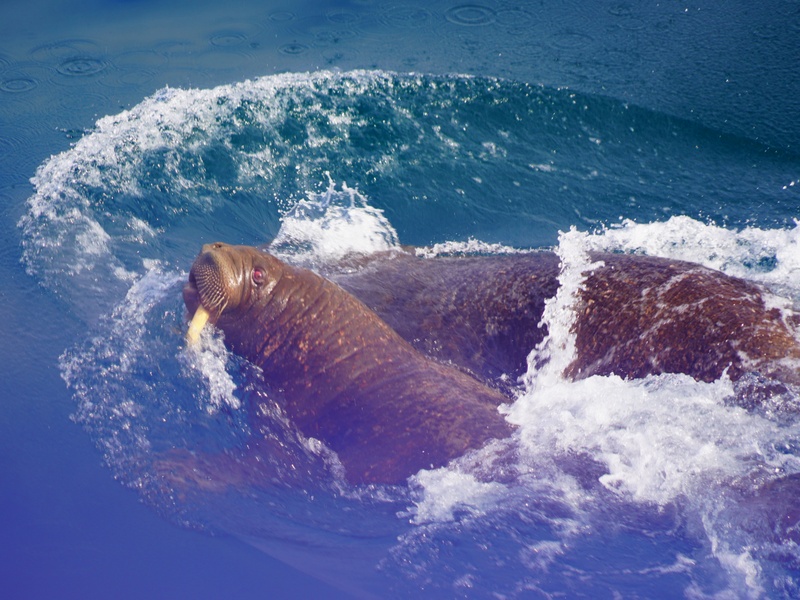
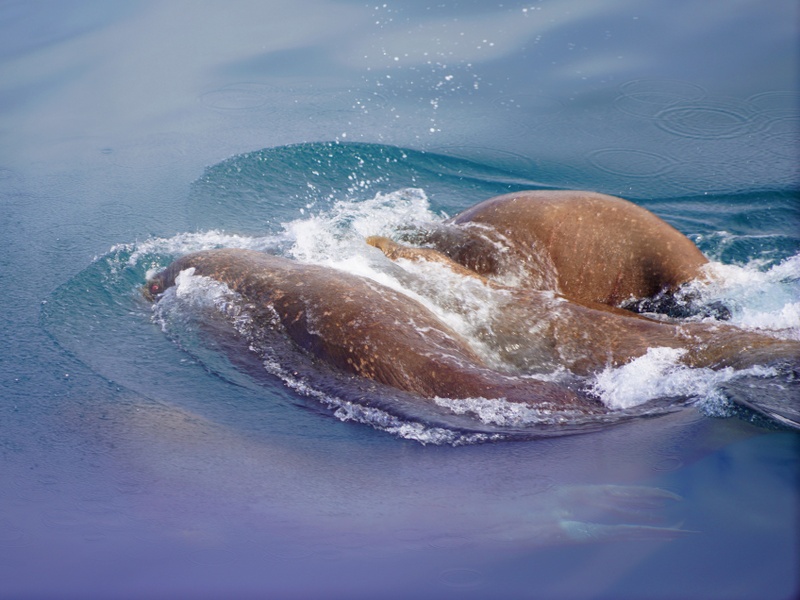
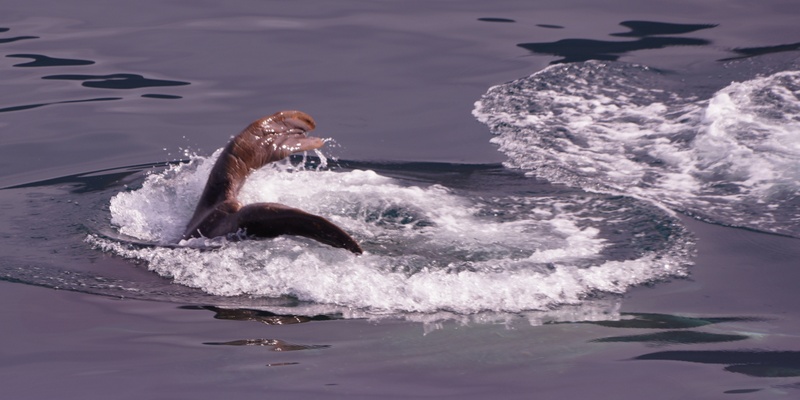
As they got too close to the ship, I could only get a few close-up photos of a couple but not the whole group. The best place to watch the spectacular show and photography turned out to be the bridge or the upper deck. Mark and keen photographers who were there managed to captured their amazing dancing movements under water!
After the walrus, we saw two bears- a mom and her cub in the water. The cub was hanging on to its mum’s back as she headed out to sea. Where were they going?
I love Ptichiy Bazar on first sight: stepped-vertical cliffs ribbon along the coast in patchy fog. Once again, we were divided into three walking groups and I was in the medium group.
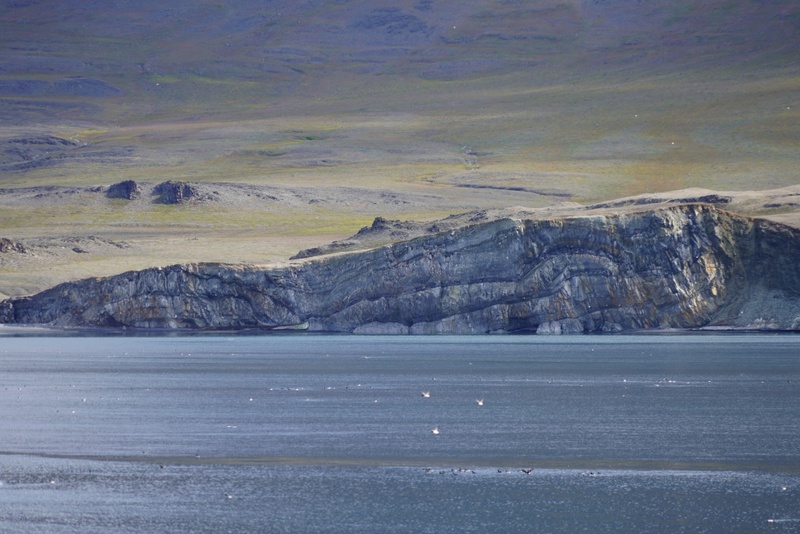
I strolled along soaking in the atmosphere. The landscape and scenery with ranges of undulating hills on one side and vertical sea cliffs and crystal-clear water on the other side was breath-taking. Mist came in and out adding a sense of place and mystery.
We made our way slowly to the cliff edge to photograph the seabird colonies. Countless Kittiwakes and Gulls were nesting on the cliffs. There were some Cormorants too. Those who trekked to the highest of the three stopping points saw Puffins as well.
The ever-changing colours and composition were excellent for photography. But the best was yet to come.
We jumped with excitement when hearing from the radio that a Grey Whale was swimming close to the cliff. I caught a glimpse of it and took a snapshot. Those behind our group standing by the low cliff had the best view: they saw the whale in water that was probably only a couple of metres deep and watched it turning to its right side and beginning feeding. It then surfaced in the most perfect light with the most perfect backdrop before disappearing. Joe, who was at the right place at the right time took a few amazing shots. It must be a breath-taking experience that has probably rarely been seen at all, let alone from a clifftop so close to where the feeding whale was.
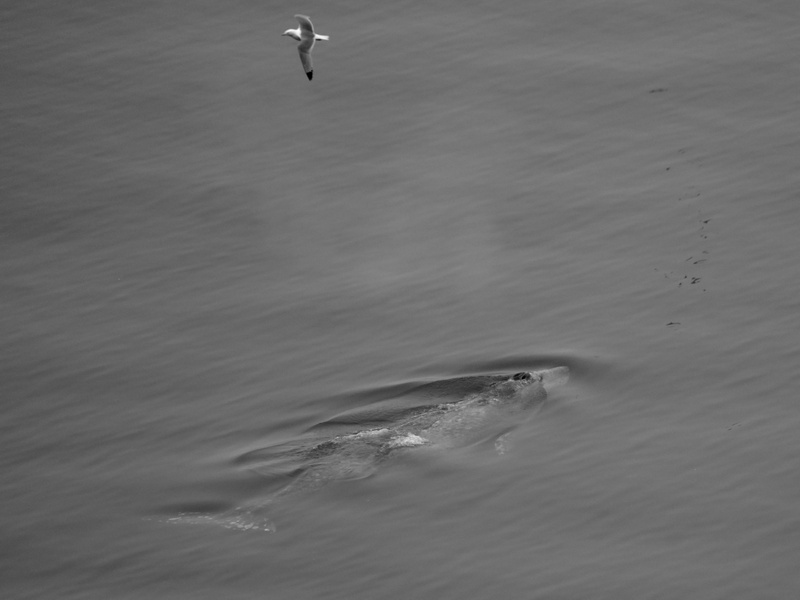
Grey Whale 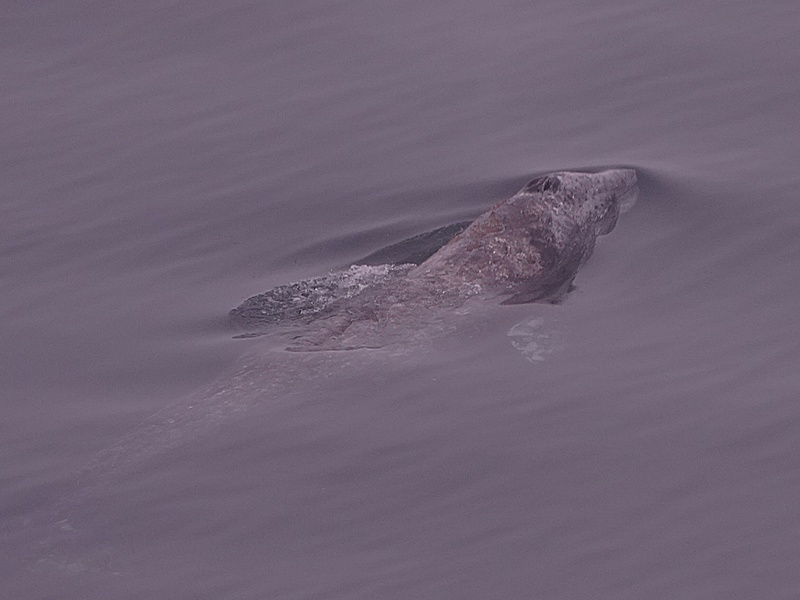
At 6:30pm, we had a recap about Beluga. After dinner, I stayed on deck to watch the landscape that was lit up with exquisite lights.
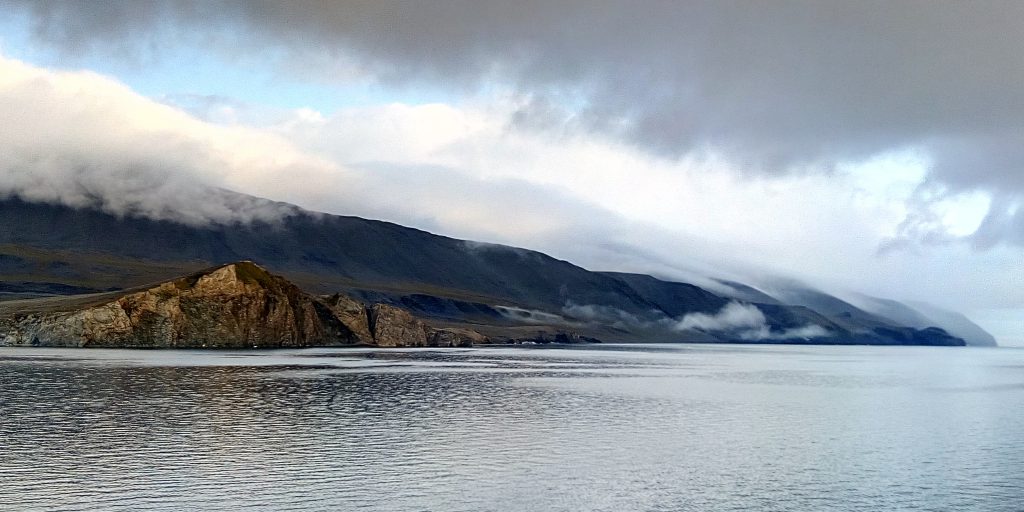
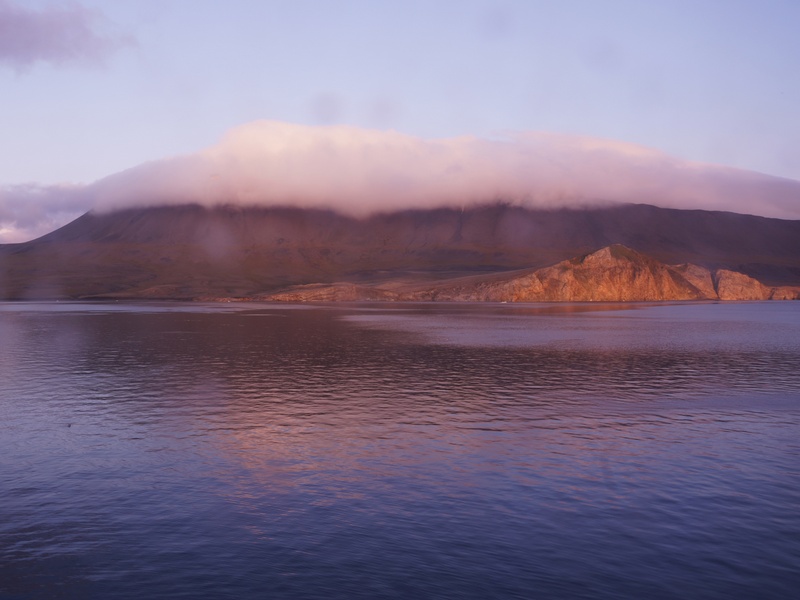
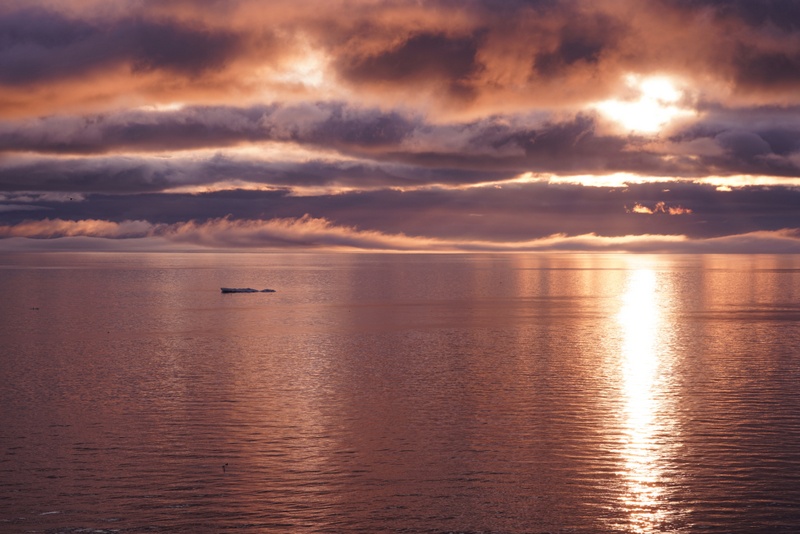
Polar Bear Count for the day: 7 & for the trip: 28
Day 7: Sunday July 28 Lake Komsomol 71°16.796’N 179°08.735’E
& Dream Head
We had a warm and sunny day with blue sky. The sea was glassy flat. After a hearty breakfast we boarded the zodiac heading for Lake Komsomol where we spent two hours.
Set back from the beach and separated from the ocean by the merest sliver of shingle spit, the lake is picturesque. At the landing site there are a couple of huts used formerly by trappers and these days by researchers.
The rangers set up a huge boundary that everyone was free to walk and explore in. Once ashore, we could see over one of the distant mountains that there was a beautiful, and distinctive, lenticular cloud – a feature associated with mountains and mountain scenery.
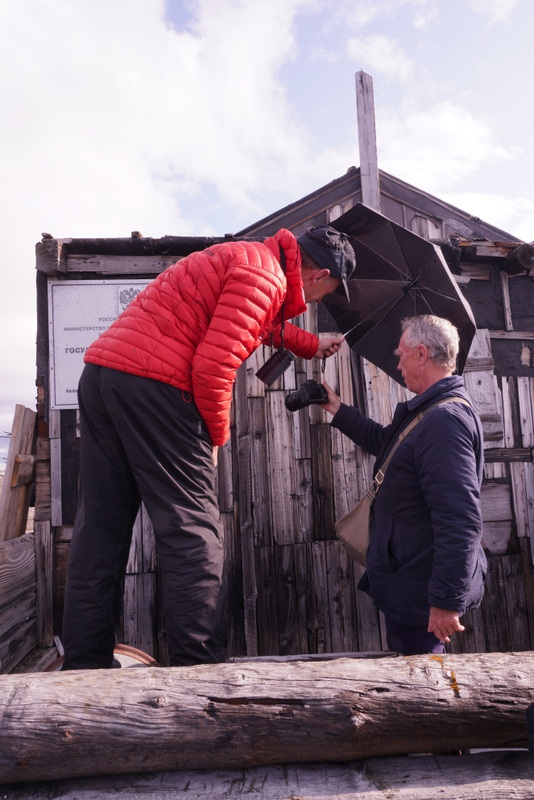
Joe giving a masterclass on landscape photography 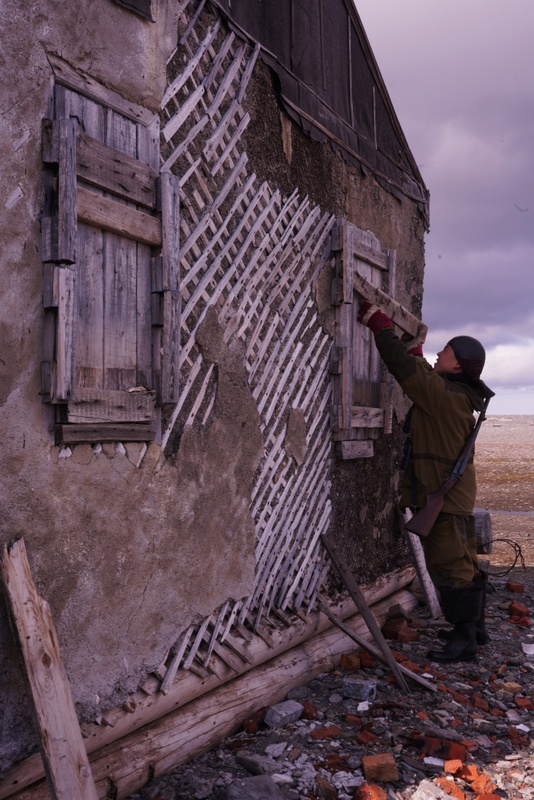
Park ranger locking up the hut
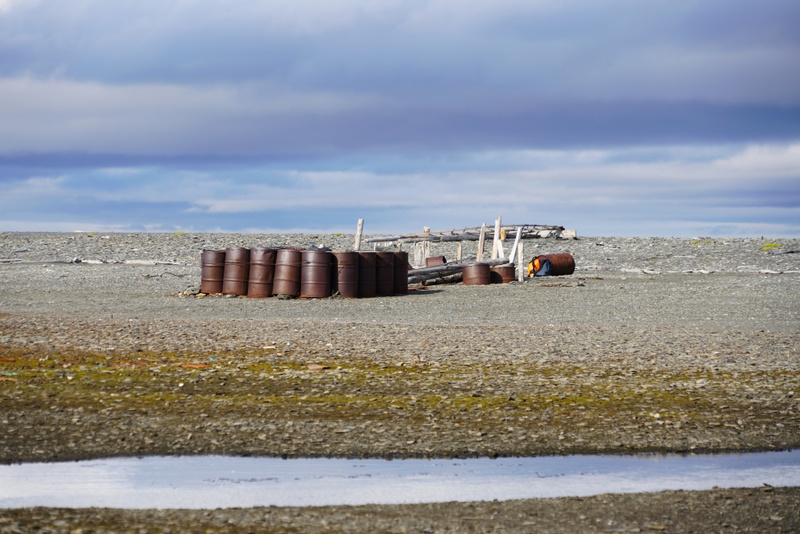
Mark and Joe conducted photography masterclass for the Wildlife Worldwide group members around the huts – wooden construction like the others we have seen. Though I was not with their group, I lined up to take a shot of a plank wood. Each of us saw the same thing but took a photo with different composition and perspective. Joe politely told me I had an interesting perspective (whatever it means!)
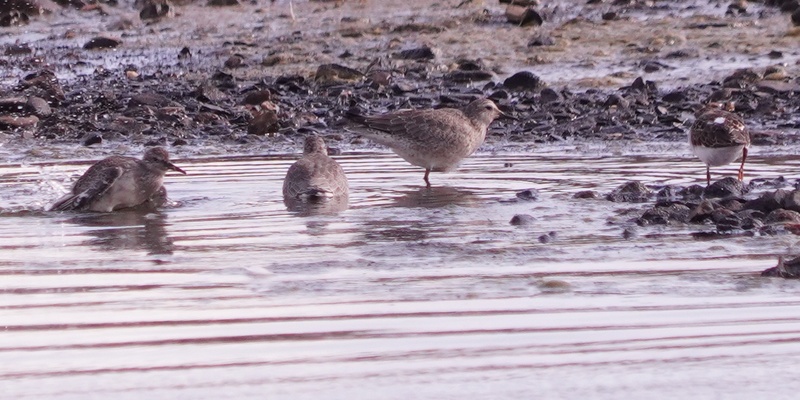
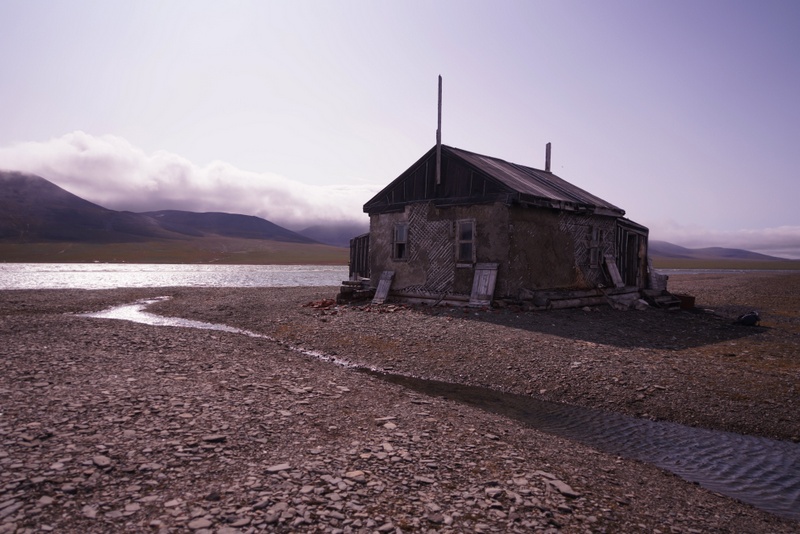
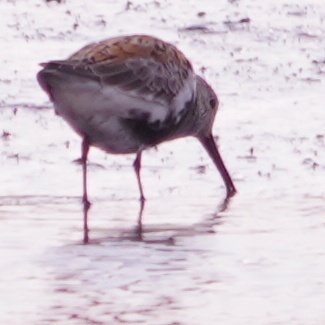
Then I spent over an hour strolling along the beach, taking photos of the driftwood, barrels and wildflowers. I also took some photos of Snow Bunting and Red-necked Stilt.
We were all back on board. Gail and her group were back on the ship while another group of five departed for an overland expedition. The weather continued to be wonderful.
From the dining room window, we could see a large herd of musk oxen feeding on tundra. Shortly after lunch, Nathan announced that we would be stopping this afternoon at Dream Head to see the musk oxen. This was an unexpected stop as we had thought we were heading for Herald Island.
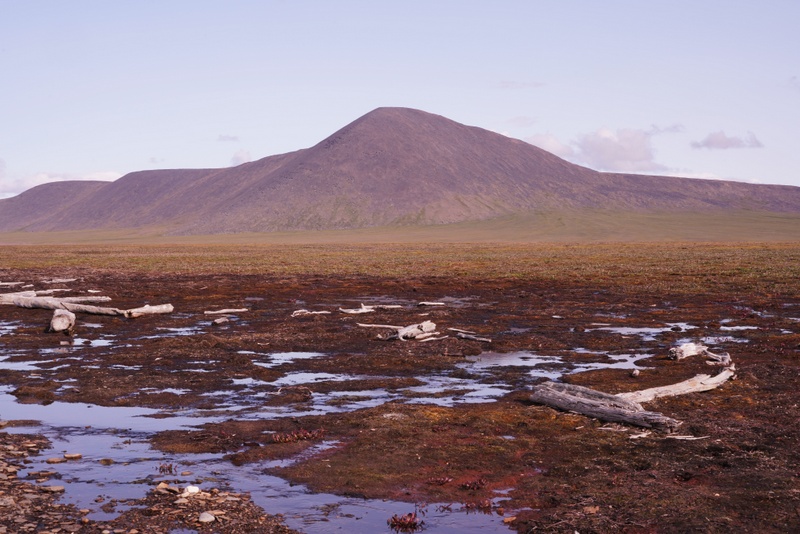
Dream Head
As we hadn’t yet seen a musk ox on this expedition, we thought it was a wonderful idea. These shaggy bovids are actually part of a herd of around 1,500 that inhabit the island. They all descend from 12 animals imported from Canada and re-introduced in 1975 to help complete the natural ecosystem. They have once again become an important part of the Wrangel landscape though their (clearly growing) numbers are limited by severe winter ice and wolf predation.
Once again, we were given a few choices of activities. A few took the long hike to a ridge for exercise and better views. I opted for a middle-distance walk along the tundra parallel to the beach towards a big group of musk oxen. The majority (about 75) joined this group!
Before setting off, the rangers scanned the mountainsides and saw three bears in all – two on the scree slopes below the mountain tops, the other was very much at ‘ground’ level in the direction of the musk oxen. Later on, a few more bears were spotted.
I had a long walk this afternoon as our target kept moving away. In any case, I found the tundra beautiful and special: its boggy and uneven terrain was covered with wildflowers.
Distance is deceptive. As the musk oxen kept moving, I finally dropped out after an hour’s walk. I sat on the grass with Gail, Samuel and half of the group to watch a large group of Snow Geese several hundred of metres away. The energetic group was about a kilometre away watching the musk oxen.
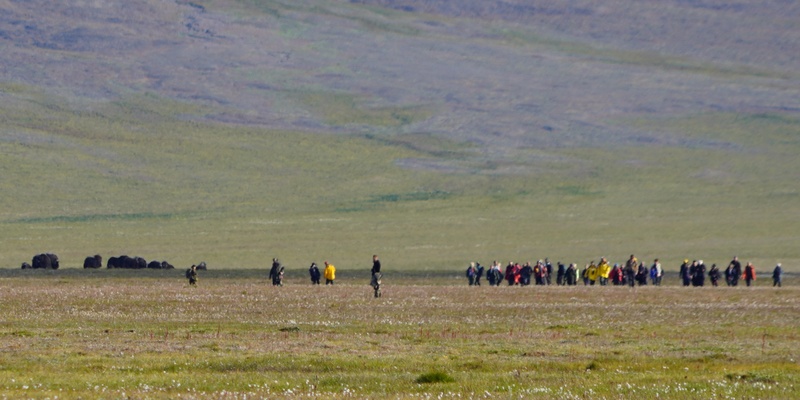
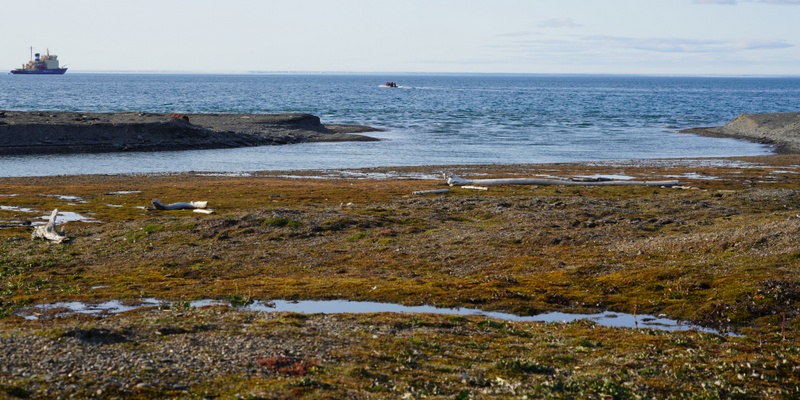
We were all back on the ship around 6 pm. We then discovered the second group on the overland adventure had returned to the ship as their vehicle had broken down! After a wholesome dinner, I was ready for bed.
Polar Bear Count for the day: 6 & for the trip: 34
Day 8: Monday July 29 Herald Island & Cape Waring (Dragi Bay) 71°22.341’N 175°41.866’W
The sea was mostly calm with ice floes. I had a good sleep but as usual got up around 3:30am. I read a bit before watching the ship approaching Herald Island. The bird cliffs though not high are spectacular. The morning light was soft and enchanting.
Nathan’s original plan was to arrange a zodiac cruise around 6 am before breakfast at 8:30 am. Owing to the sea swell and wind conditions, he had to cancel the plan. Instead, we had a ship cruise.
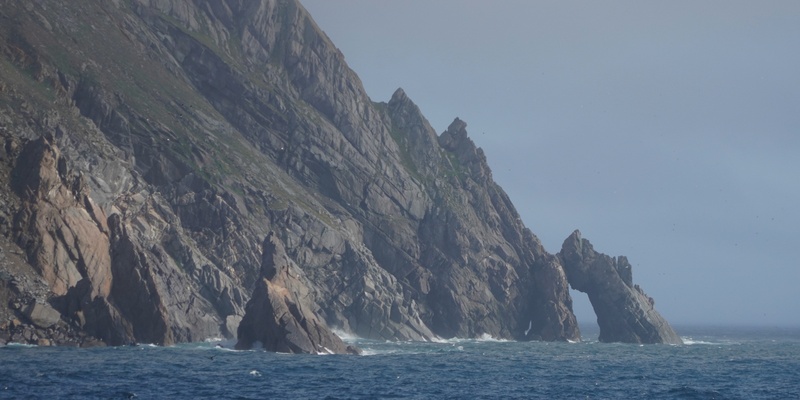
We sailed through uncharted waters and had spectacular views of the island which was covered partially by thick and dark clouds. Few persons have landed on this island. Captain Kellett was the first person to land in 1849 and described it as “an inaccessible rock”. John Muir landed on the Corwin arrived a few decades later. Then a group of four men from the wrecked Karluk had died here. Debris from their camp along with skeletal remains were found in 1924 by the crew of a US ship. More recently, rangers have periodically stayed on the island to carry out research on Polar Bears.
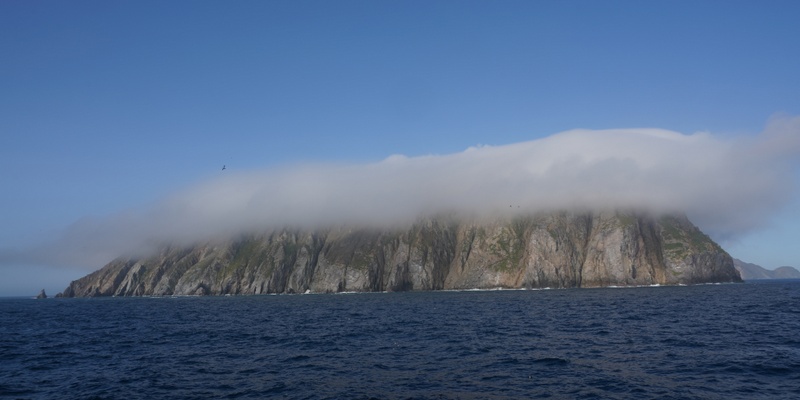
Nathan and team said they spotted five bears on the island, the majority of which was found at the western end. I at the most had spotted two tiny dots.
After Herald Island, we made our way back to Wrangel Island. Nathan had hoped to get close to the monument constructed in memory of the Karluk expedition at Dragi Bay. But the sea conditions would not allow a landing. We therefore had to land on a more southerly part of the beach about a kilometre or so away.
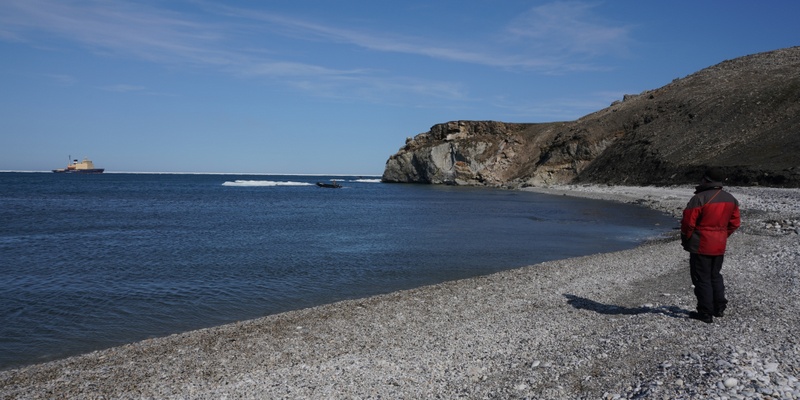
Once ashore, Mark and Chris led the group towards a nearby rangers hut midway up a hill. We were all taken by surprise to find a sleeping bear at the foot of a hill less than 200m to our left. About 150m on the left stood a male musk ox across the river we had just waded across.
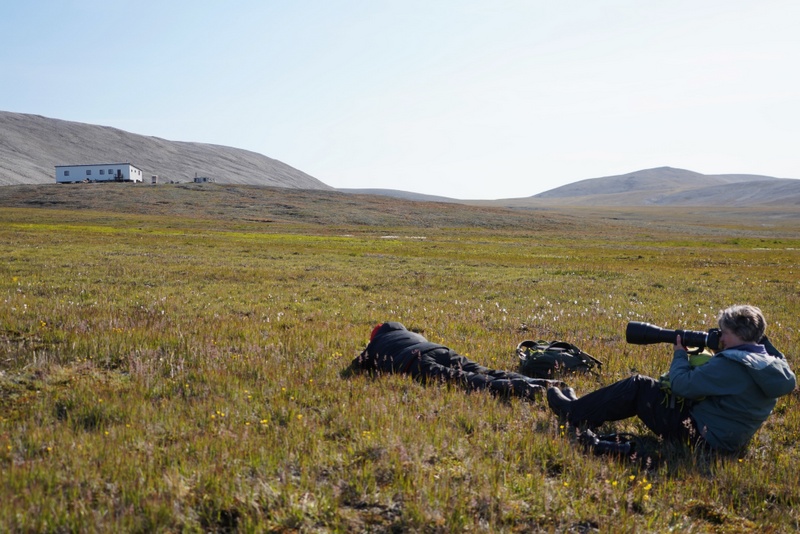
A Bear on the left 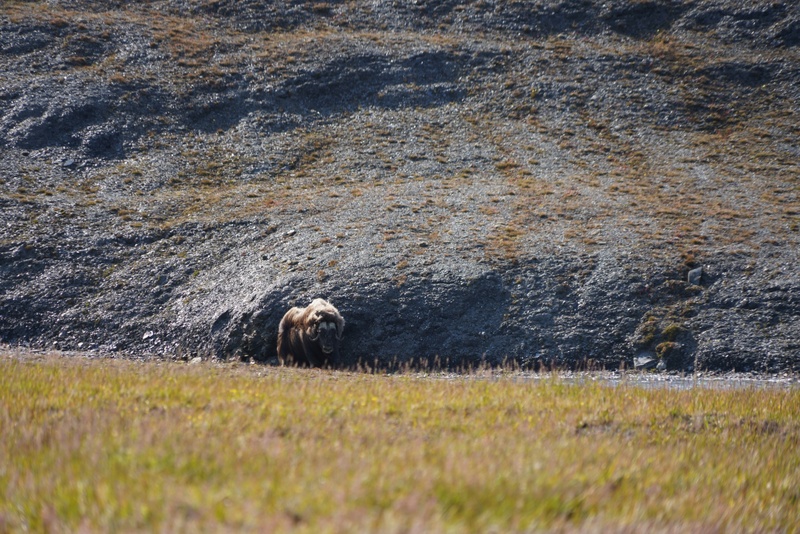
A musk ox on the right
Wow, we were lucky to see a bear on foot which was not posing as a threat. We watched it sleeping. When it woke up, it sauntered the short distance from where it had curled up to the rangers hut. It seemed more conscious of our presence at one point. But as we were quite a large group, it walked on without paying any attention to us.
We stayed where we were watching the bear and the musk ox for about half an hour. Then we headed back towards the beach via a high point on the nearby cliff.
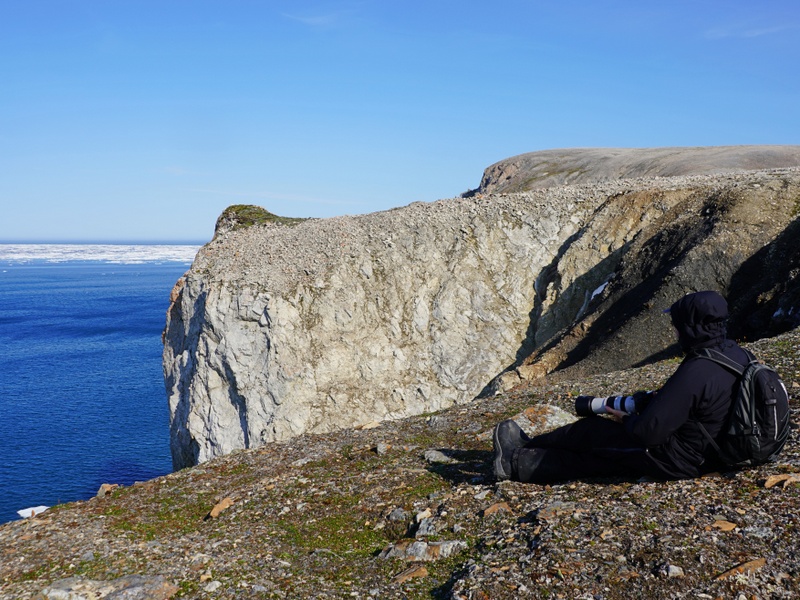
Time for Reflection
Back on the ship, we headed out into the ice and within 30 minutes or so, we saw three (more!) polar bears. One was far off while the mum and cub were close by and beautifully positioned in the light. We were with them for half an hour or more – it was perhaps the best polar bear encounter of the expedition.
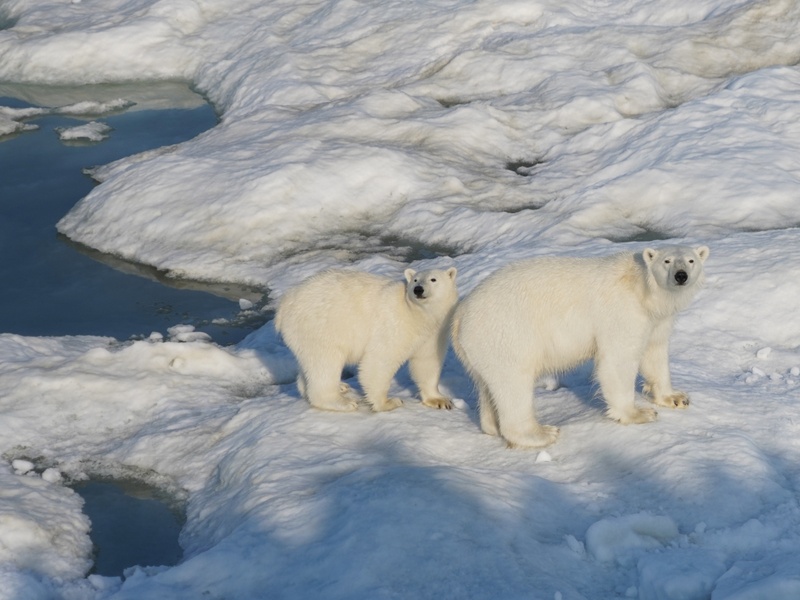
When this pair moved away, two more bears appeared on pack ice. A magical day!
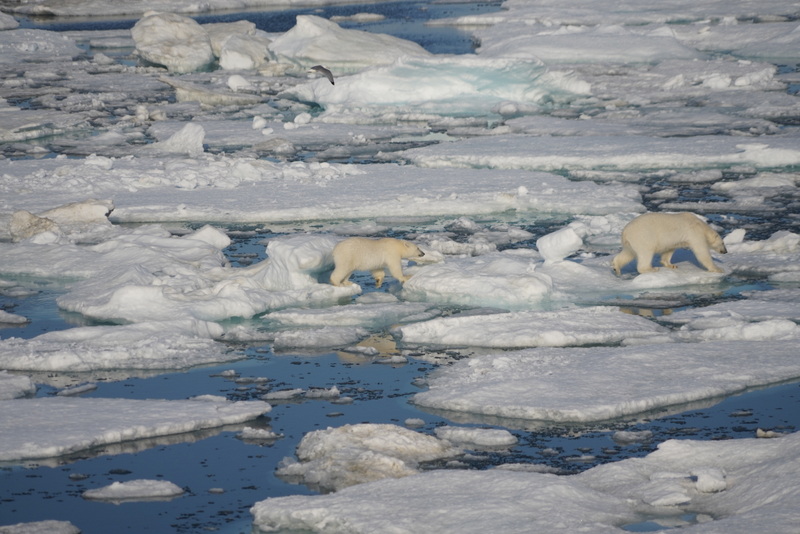
We had an extremely busy day. On top of two landings and bear watching, we had a lecture by one of the rangers on the island and by Mark on ‘Never, Ever, Ever Write a Field Guide’. Mark, a zoologist by training and an expert on whales, has written some 60 books so far and will soon published a guide on whales.
Polar Bear Count for the day: 13 & for the trip: 47
Day 9: Tuesday July 30 Doubtful Harbour 70°54.310’N 179°58.749’W – Last landing on Wrangel Island
I got up at 5 am and continued my reading of Jennifer Niven’s book ‘The Ice Master: The Voyage of the Karluk 1912-1914’.
The weather was not good: cold and drizzly. We had an overcast sky. It was so foggy that we could not see Doubtful Harbour which was some seven miles away. Though the sea was relatively calm, the ice made it difficult for the ship to get closer.
As a result, we had to take a long and cold long journey from the ship to shore. The majority decided to brave the adverse weather to go ashore. The transfer was around 45 minutes in thick fog. All nine zodiac drivers had to travel in a line with only 30m or so between boats. It was the most atmospheric and memorable zodiac ride of the expedition. I wished I had taken my camera out of the dry bag to take a photo.
After some 35 minutes, we finally saw the pebble coastline of Doubtful Harbour. We got off just east of the river.
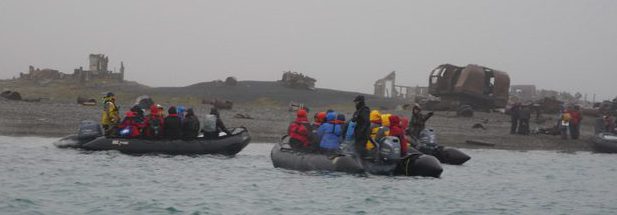
With the thick fog and thousands of rusty barrels, old bricks and derelict buildings, aircraft parts and abandoned vehicles, the place looked surreal. I thought I was on a time capsule and had landed on another planet.
This place is unique and atmospheric providing an excellent backdrop for filming and photography masterclass. I love the wildflowers in dew. I saw a couple of lemmings, snow bunting and other birds.
I asked Joe to take a photo for me with the 4,000-years-old mammoth tusk in my hand. There can’t be many places on earth where one can see and touch a mammoth’s tusk where they came out of the ground.
We visited the rangers hut which is cosy and liveable. We said goodbye to the rangers who had accompanied us for the past few days.
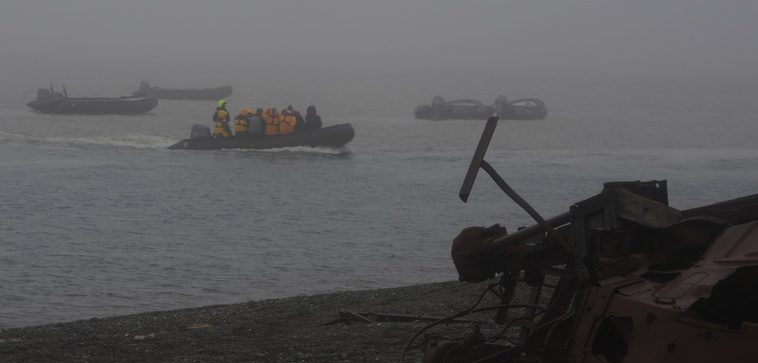
The fog had cleared up a bit now. We were able to see the ship in a distance: this made our homeward journey much easier. Anyway, for safety reasons, Nathan arranged zodiacs going in pair.
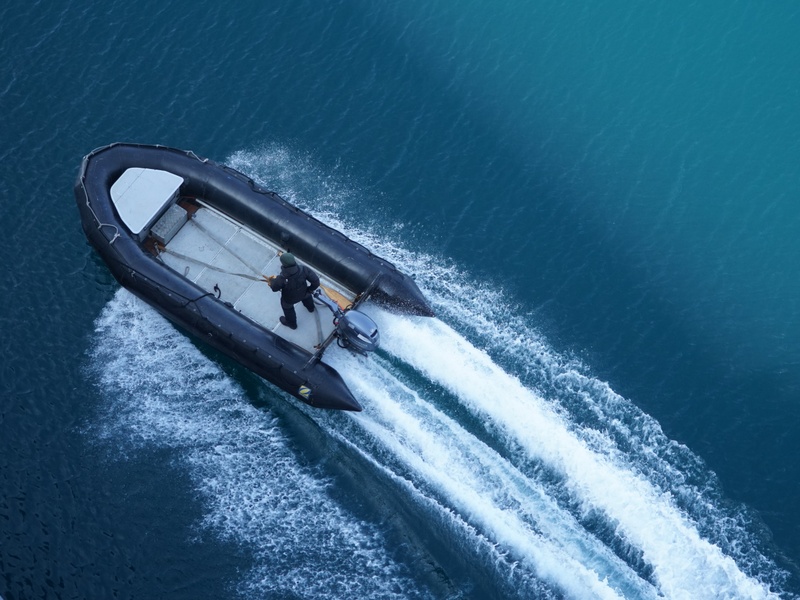
We began heading south after circumnavigating Wrangel Island in five days. I was told that only a dozen ships would visit Wrangel Island this year (including three from HF). We are the lucky and privileged few who have spent so much time exploring the awesome island.
After lunch, we attended Katie’s talk on ‘The Voyage of the Karluk’ which was interrupted when three polar bears on ice flows appeared ahead of the ship.
We of course had our priority right: we rushed out to watch the bears. After the bears, we had a group of walrus.
Katie’s lecture resumed later. Anyway, I was glad that I had read book ‘The Ice Master: The Voyage of the Karluk 1912-1914’. Karluk was never built for the Arctic Sea ice. After drifting in ice for five months, it sank just north of Wrangel Island in January 1914. Four men perished on Herald Island and another four were lost on ice. The remainder of the crew eventually made landfall on Wrangel Island where most of them spent the next nine months at a camp at Cape Waring. Captain Bartlett accompanied by the Yupik hunter Kataktovik walked to Siberian coast to seek help. Three had died before a Canadian trading schooner King and Winge rescued the survivors in September.
Moshe gave an interesting talk on ‘The Flora and Fauna of Wrangel Island’ with lots of photos. I think I have seen most of the plants and flowers he has mentioned. But as usual, I forget the names.
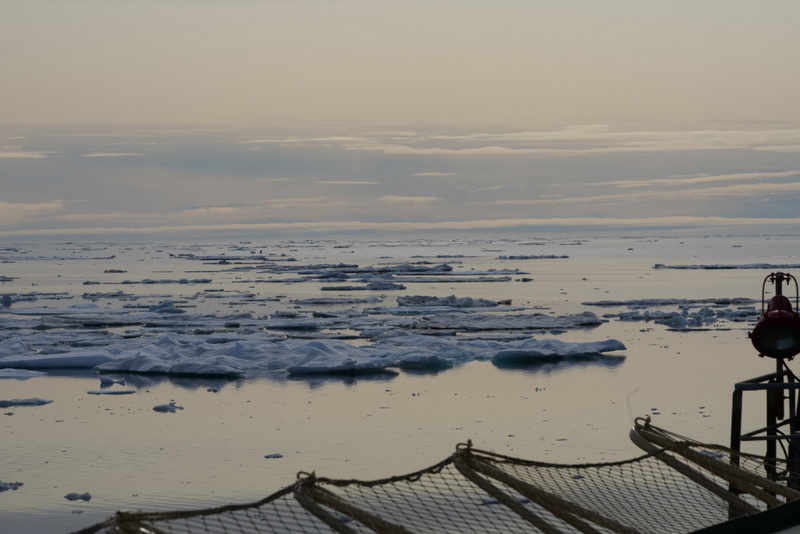
During the bar chat, Mark and Joe touched on the pertinent topic of ‘Climate Change’. During the pre-dinner recap, Nathan gave a quick review of our incredible voyage with a series of iconic Wrangel images taken during the course of our circumnavigation.
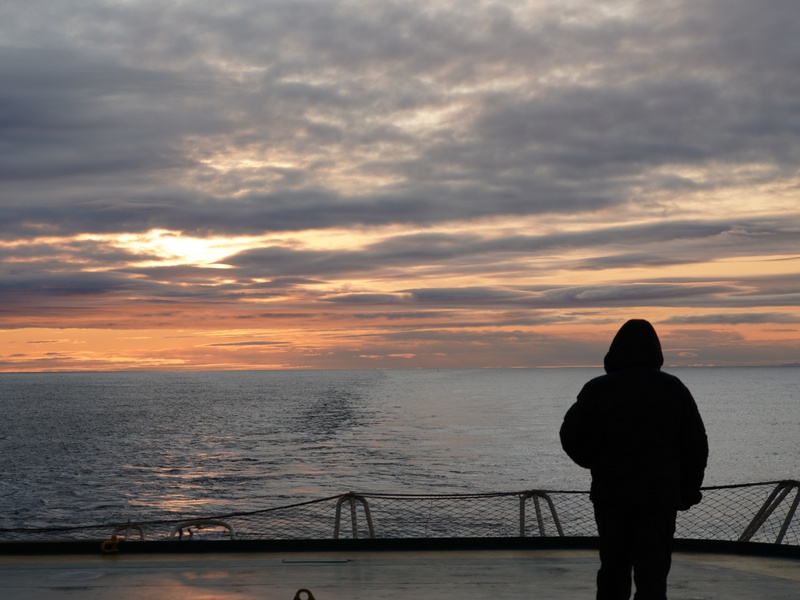
Polar Bear Count for the day: 5 & for the trip: 52


